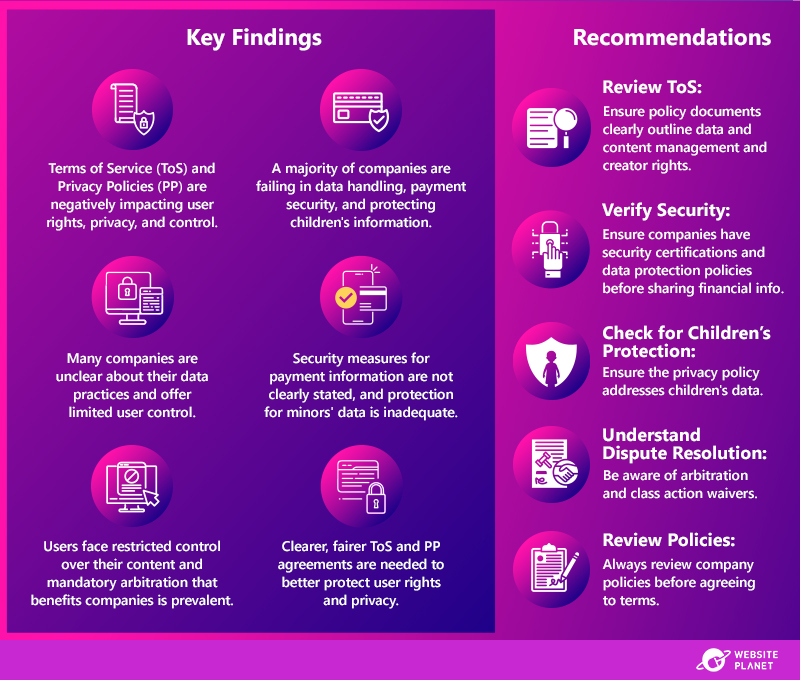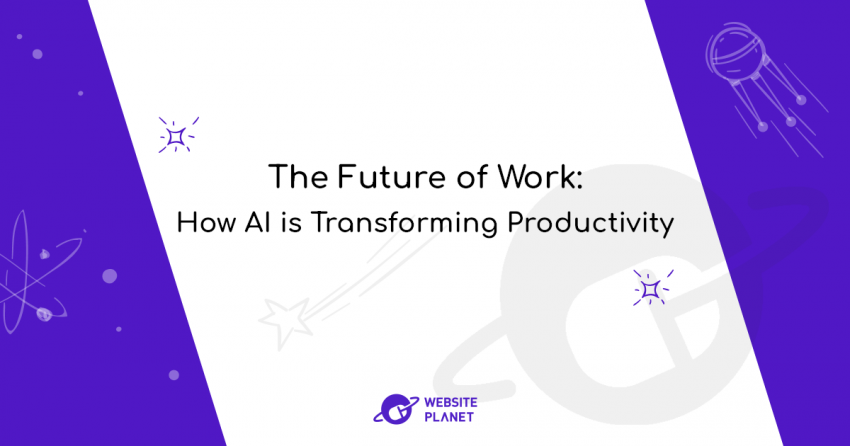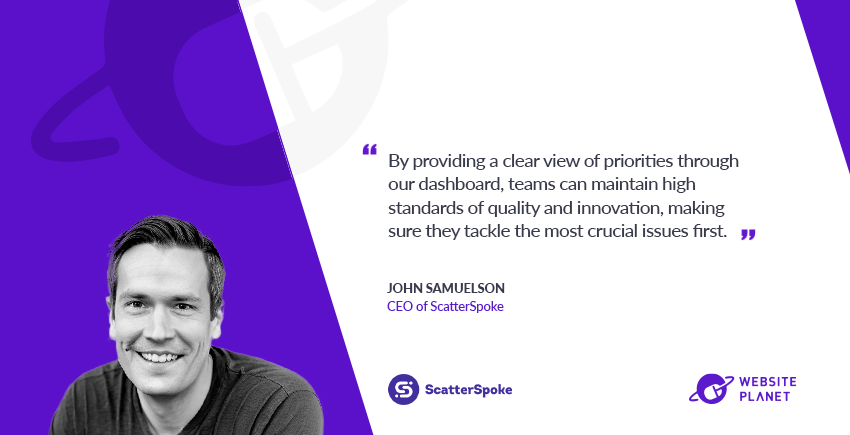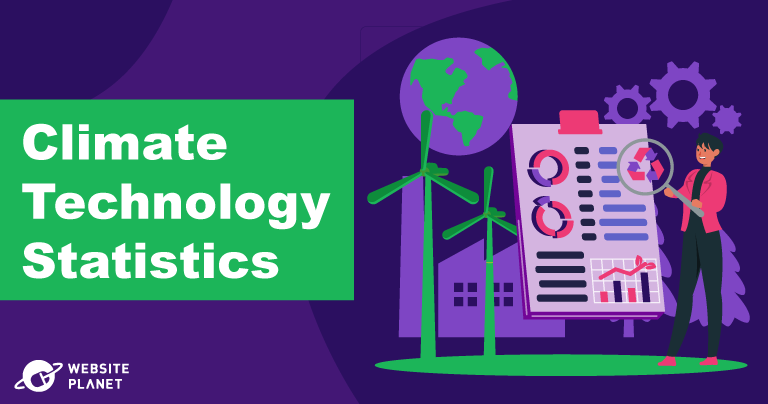Inside this Article
COVID-19 and Employment: A Snapshot
The pandemic not only took a toll on our health and livelihood, but it also shook the global economy and, subsequently, the employment landscape. Here are some of the ways COVID-19 left its mark on the global job market.1. A Cut in Earnings
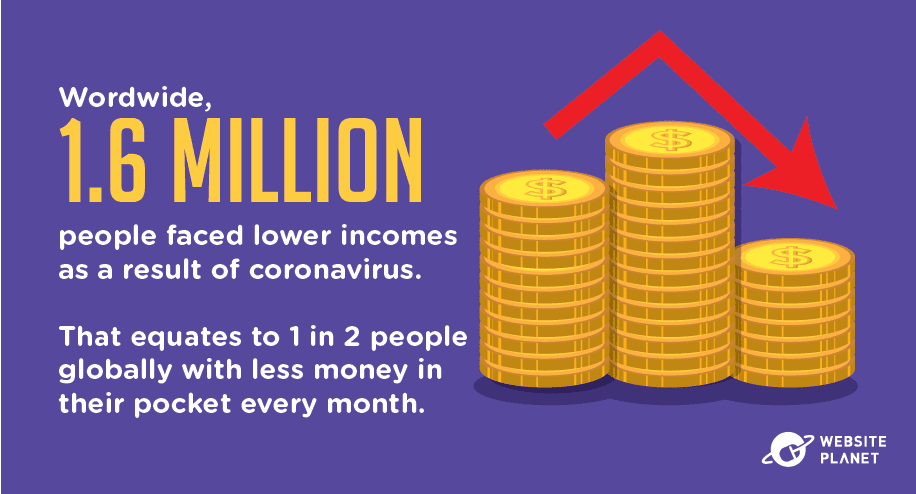 COVID-19 put a halt on employment for many around the world. While some people were forced to take a break from employment, others had no job to return to when the pandemic shifted.
Worldwide, 1.6 billion people faced lower incomes as a result of coronavirus. That equates to 1 in 2 people globally with less money in their pocket every month.
COVID-19 put a halt on employment for many around the world. While some people were forced to take a break from employment, others had no job to return to when the pandemic shifted.
Worldwide, 1.6 billion people faced lower incomes as a result of coronavirus. That equates to 1 in 2 people globally with less money in their pocket every month.
2. A Drop in Working Hours
 A loss in earnings wasn’t the only negative impact of COVID-19. With fewer people in employment, the pandemic also caused a massive drop in working hours.
In 2020, it’s estimated that 8.8% of total working hours were lost, based on a 48-hour working week. In terms of full-time employment, that equates to 255 million jobs.
A loss in earnings wasn’t the only negative impact of COVID-19. With fewer people in employment, the pandemic also caused a massive drop in working hours.
In 2020, it’s estimated that 8.8% of total working hours were lost, based on a 48-hour working week. In terms of full-time employment, that equates to 255 million jobs.
3. More People Were Inactive Than Unemployed
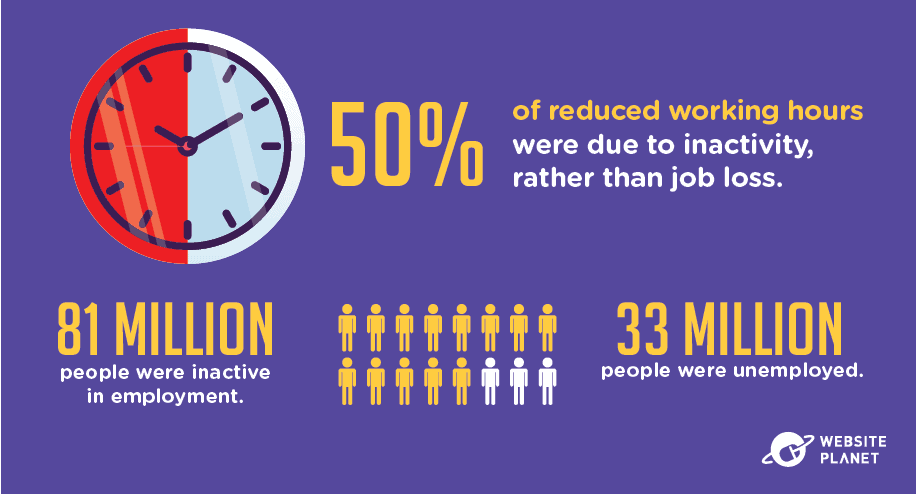 Around half of all working hour losses resulted from reduced hours by people who were still employed, but who received support from government recovery schemes.
In fact, inactivity in employment actually increased at a much higher rate than the number of people who lost their jobs. Around 81 million people shifted to inactive during the pandemic, compared with 33 million people left unemployed.
Around half of all working hour losses resulted from reduced hours by people who were still employed, but who received support from government recovery schemes.
In fact, inactivity in employment actually increased at a much higher rate than the number of people who lost their jobs. Around 81 million people shifted to inactive during the pandemic, compared with 33 million people left unemployed.
4. More Job Losses Among Employed Than Self-Employed
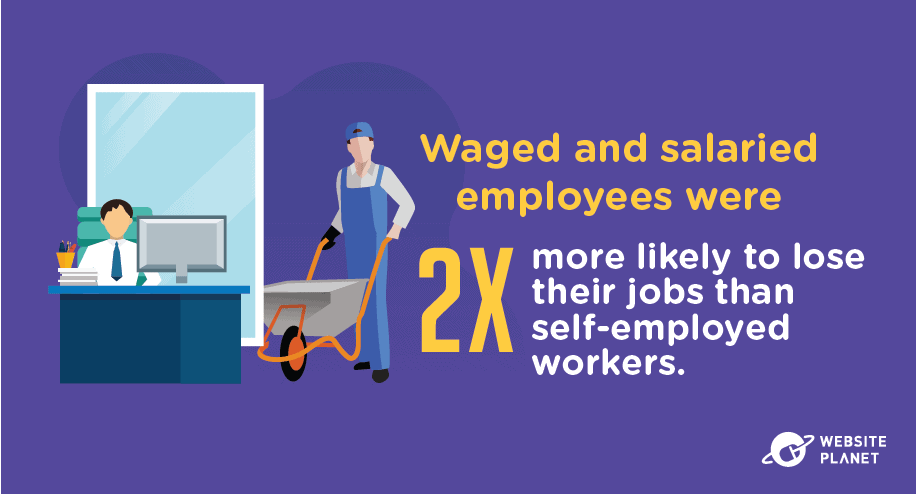 Surprisingly, unemployment rates among waged and salaried employees were estimated to be twice as much as self-employed workers. This continued even after a gradual increase in work due to the relaxation of restrictions.
While many waged and salaried employees were likely still inactive due to government employment schemes, it nevertheless shows a shift in work among the labor market, with the future-leaning more towards a self-employed job market.
Surprisingly, unemployment rates among waged and salaried employees were estimated to be twice as much as self-employed workers. This continued even after a gradual increase in work due to the relaxation of restrictions.
While many waged and salaried employees were likely still inactive due to government employment schemes, it nevertheless shows a shift in work among the labor market, with the future-leaning more towards a self-employed job market.
5. Lower-Income Countries Were Hit the Hardest
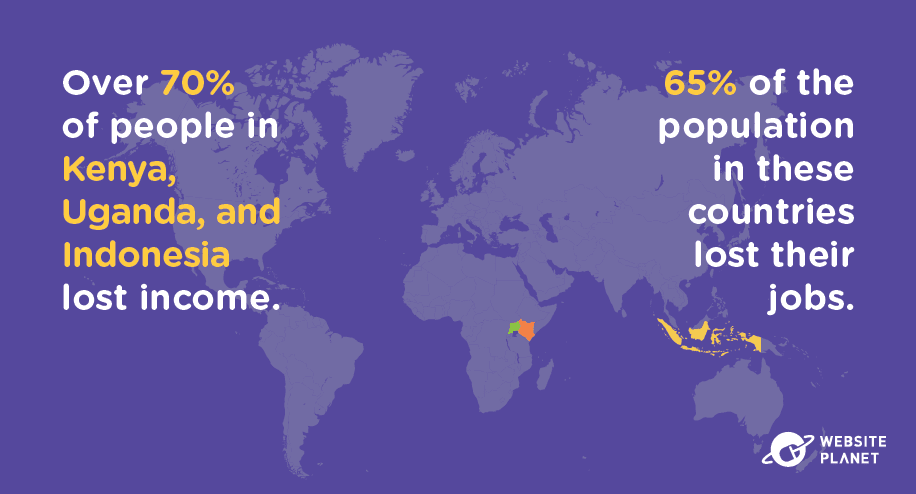 Unemployment rates were not linear across countries, with lower-income countries facing a much greater struggle.
In Kenya, Uganda, and Indonesia, over 70% of people saw a loss in earnings due to the pandemic. In high-income countries such as the USA, only 34% of the population took a pay cut.
Similarly, 13% of people in the USA faced job losses compared to 65% in low-income countries — highlighting the need for greater job security, formal employment, and government support.
Unemployment rates were not linear across countries, with lower-income countries facing a much greater struggle.
In Kenya, Uganda, and Indonesia, over 70% of people saw a loss in earnings due to the pandemic. In high-income countries such as the USA, only 34% of the population took a pay cut.
Similarly, 13% of people in the USA faced job losses compared to 65% in low-income countries — highlighting the need for greater job security, formal employment, and government support.
6. Fewer Jobs Lost in the EU Than the USA
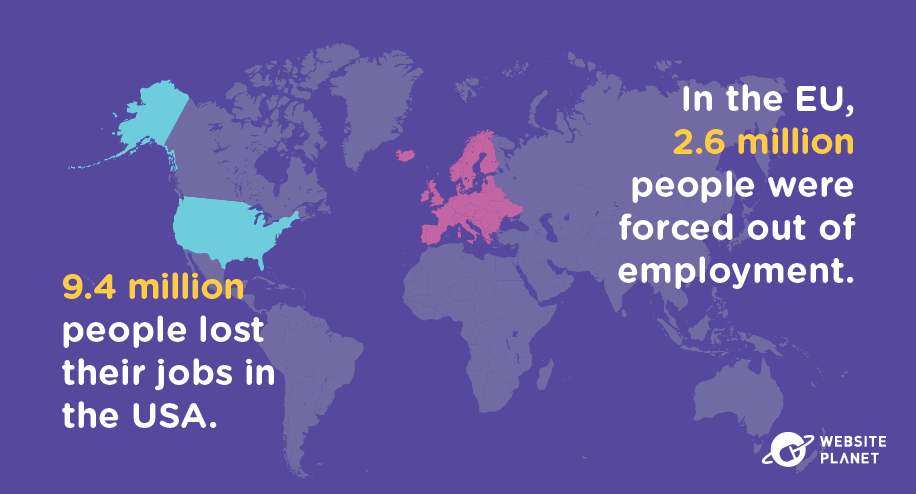 While the pandemic has affected the job market globally, some countries took a greater hit than others. The EU and the USA certainly faced a very different fate.
In the USA, around 9.4 million people aged 16-64 have lost their jobs since the pandemic began. In the EU, this figure dropped to 2.6 million, despite being home to around 100 million more people.
Job loss also varied among states, with unemployment rates rising rapidly in Hawaii, Nevada, California, Los Angeles, and New York.
While the pandemic has affected the job market globally, some countries took a greater hit than others. The EU and the USA certainly faced a very different fate.
In the USA, around 9.4 million people aged 16-64 have lost their jobs since the pandemic began. In the EU, this figure dropped to 2.6 million, despite being home to around 100 million more people.
Job loss also varied among states, with unemployment rates rising rapidly in Hawaii, Nevada, California, Los Angeles, and New York.
7. Latin America and the Caribbean Most Affected by the Pandemic
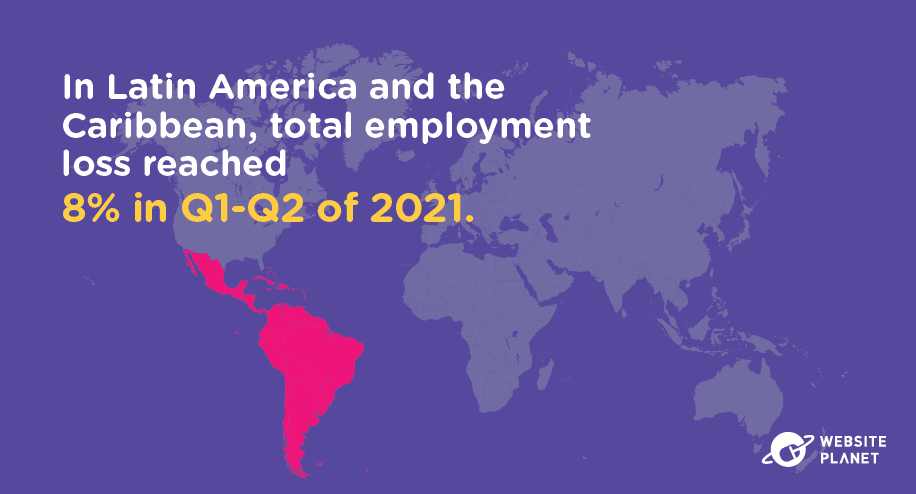 Many stable, high-income countries were able to lessen the effects of the pandemic. However, low-skilled workers in Latin America and the Caribbean saw a much higher rate of job losses, with many being forced out of formal employment and into informal work.
The total amount of job losses in these 2 regions exceeded 8% in the first 6 months of 2021 — the highest of any region — with Europe and Central Asia following closely behind.
Many stable, high-income countries were able to lessen the effects of the pandemic. However, low-skilled workers in Latin America and the Caribbean saw a much higher rate of job losses, with many being forced out of formal employment and into informal work.
The total amount of job losses in these 2 regions exceeded 8% in the first 6 months of 2021 — the highest of any region — with Europe and Central Asia following closely behind.
8. COVID-19 Left Women Out of Employment
 While COVID-19 forced both men and women out of work, women were hit harder. COVID-19 only created a larger gap in terms of gender equality, with 4.2% of the global female population out of work, compared to 3% of men.
The burdens of childcare and home-schooling are 2 contributing factors to women leaving the labor force, as well as the actual type of employment. Many women work in informal roles and care-type employment, which means they are more likely to lose their jobs when compared to men. Nevertheless, these setbacks in gender equality are likely to continue for a while yet.
While COVID-19 forced both men and women out of work, women were hit harder. COVID-19 only created a larger gap in terms of gender equality, with 4.2% of the global female population out of work, compared to 3% of men.
The burdens of childcare and home-schooling are 2 contributing factors to women leaving the labor force, as well as the actual type of employment. Many women work in informal roles and care-type employment, which means they are more likely to lose their jobs when compared to men. Nevertheless, these setbacks in gender equality are likely to continue for a while yet.
9. The Pandemic Put a Halt on Youth Employment
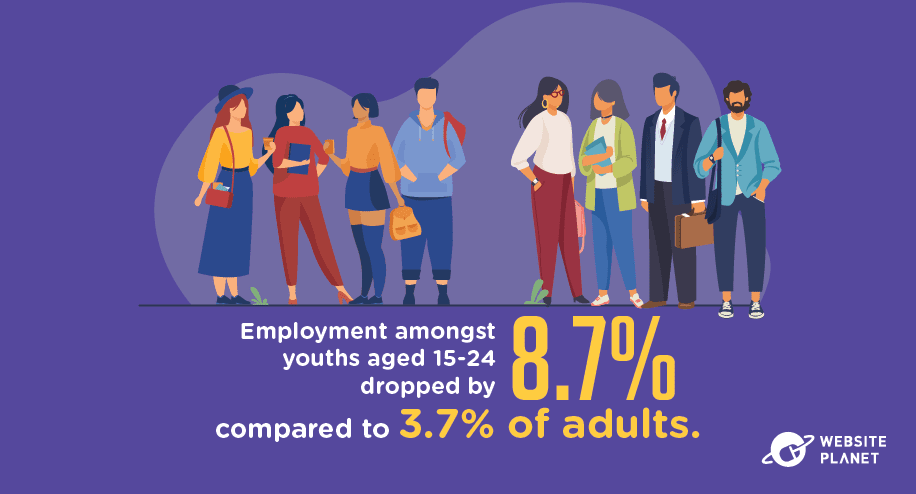 COVID-19 also favored older, more experienced workers over youths. The majority of young people left unemployed due to the pandemic was significantly higher than any other age group.
In 2020, youth employment (aged 15-24) decreased by 8.7%, compared to 3.7% of adults. In total, more than 1 in 6 young people lost their jobs — making the next generation and the future of our labor workforce highly vulnerable.
COVID-19 also favored older, more experienced workers over youths. The majority of young people left unemployed due to the pandemic was significantly higher than any other age group.
In 2020, youth employment (aged 15-24) decreased by 8.7%, compared to 3.7% of adults. In total, more than 1 in 6 young people lost their jobs — making the next generation and the future of our labor workforce highly vulnerable.
10. Global Labor Income Decreased Significantly
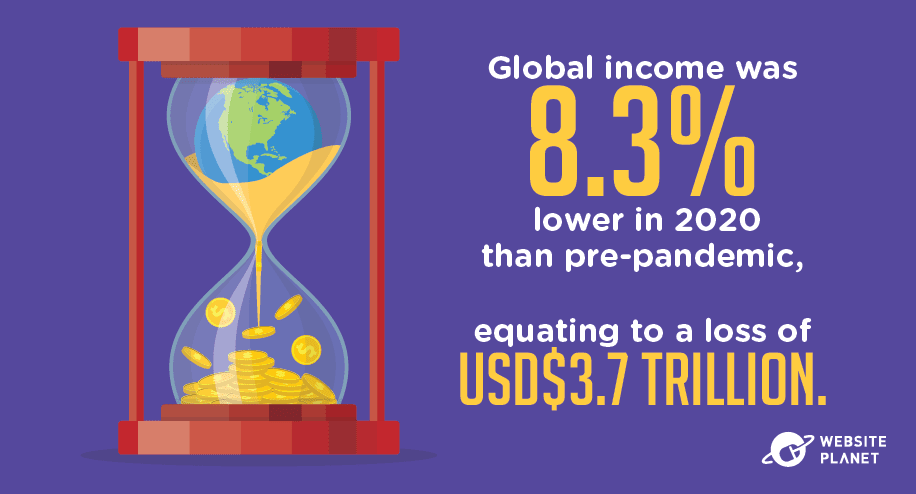 With more people out of work and a drop in working hours, the global economy suffered.
In 2020, global labor income was 8.3% lower in 2020 than projected without the pandemic. This equates to a loss of US$3.7 trillion, without including any government transfers or benefits.
The effects are still being felt in the first half of 2021. While the total income loss has dropped to 5.3%, that still means global labor income is facing a shortfall of US$1.3 trillion — and the road to recovery is long.
With more people out of work and a drop in working hours, the global economy suffered.
In 2020, global labor income was 8.3% lower in 2020 than projected without the pandemic. This equates to a loss of US$3.7 trillion, without including any government transfers or benefits.
The effects are still being felt in the first half of 2021. While the total income loss has dropped to 5.3%, that still means global labor income is facing a shortfall of US$1.3 trillion — and the road to recovery is long.
11. Covid Posed a High Threat to Booming Businesses
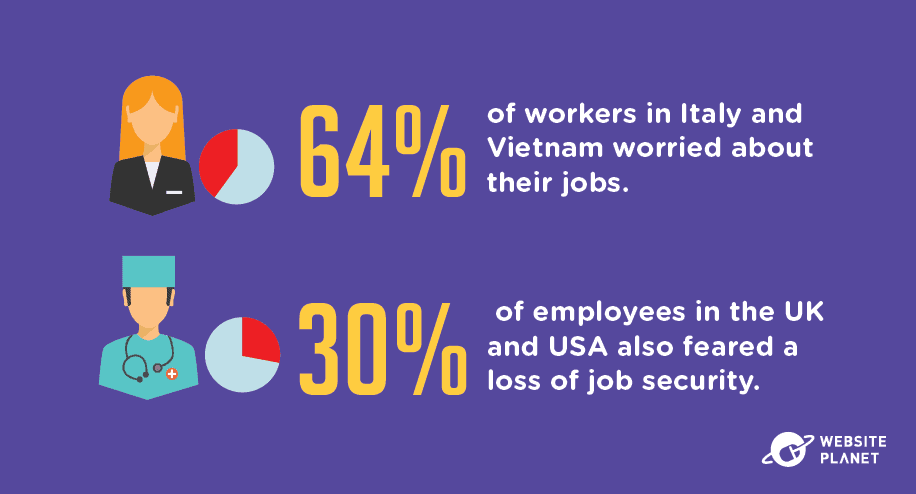 Businesses that were once thriving pre-pandemic faced an uphill struggle once they were forced to shut down or lay off their employees.
An increasing number of businesses worldwide were significantly worried about COVID-19 posing a high or very high threat to their company.
In Italy and Vietnam, these worries were felt most strongly. Up to 64% of respondents worried about their job or business amidst the pandemic. Even in high-income countries such as the UK and USA, over 30% of respondents shared the same views.
Businesses that were once thriving pre-pandemic faced an uphill struggle once they were forced to shut down or lay off their employees.
An increasing number of businesses worldwide were significantly worried about COVID-19 posing a high or very high threat to their company.
In Italy and Vietnam, these worries were felt most strongly. Up to 64% of respondents worried about their job or business amidst the pandemic. Even in high-income countries such as the UK and USA, over 30% of respondents shared the same views.
12. Employment Growth is Expected
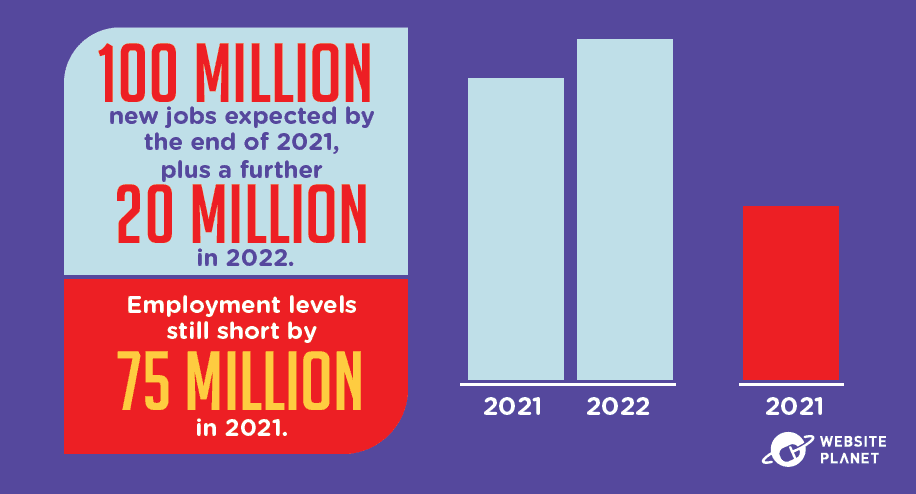 As the world returns to work post-pandemic, employment levels are expected to rise, with the creation of 100 million new jobs in 2021, and a further 20 million jobs in 2022.
Overall, however, COVID-19 has still created a global shortfall in available employment opportunities, and there will not be as many jobs available had there been no pandemic. In total, the global labor market is expected to see 75 million fewer jobs available in 2021 and 23 million in 2022.
As the world returns to work post-pandemic, employment levels are expected to rise, with the creation of 100 million new jobs in 2021, and a further 20 million jobs in 2022.
Overall, however, COVID-19 has still created a global shortfall in available employment opportunities, and there will not be as many jobs available had there been no pandemic. In total, the global labor market is expected to see 75 million fewer jobs available in 2021 and 23 million in 2022.
While Some Businesses Face Losses, Others Thrive
COVID-19 left a huge imprint on many businesses, but not always for the same reason. Although many businesses suffered huge losses and were forced to close completely, others increased sales and grew much larger.13. Hospitality Sectors Suffered Greatly
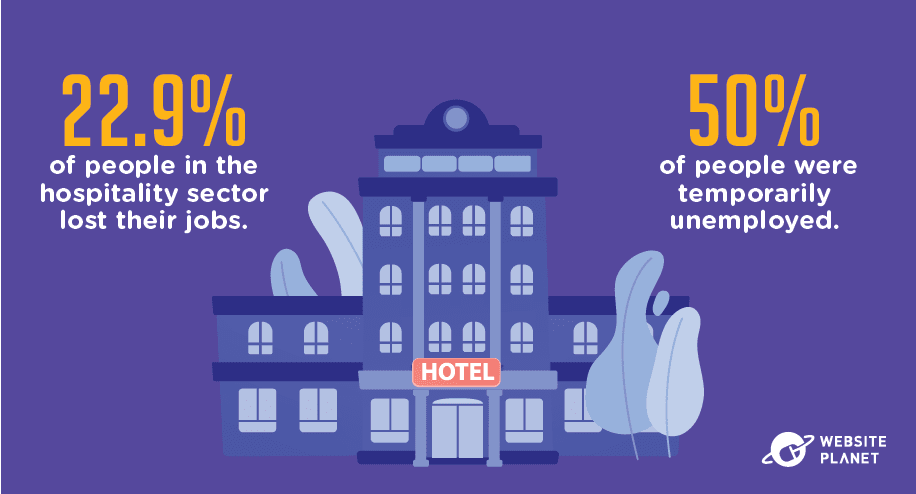 For some businesses, the move to work from home was an easy switch. But more vulnerable sectors faced a complete loss of work and income — especially the hospitality sector.
Restaurants, retail, accommodation, sports, and gambling, and betting businesses were the most affected by the pandemic, with the accommodation sector bearing the biggest impact.
In the accommodation sector, COVID-19 created a loss of 22.9% in employment and forced 50% of employees temporarily out of work in the second quarter of 2020.
Food and beverage wasn’t far behind, with a 17.9% loss in employment levels.
For some businesses, the move to work from home was an easy switch. But more vulnerable sectors faced a complete loss of work and income — especially the hospitality sector.
Restaurants, retail, accommodation, sports, and gambling, and betting businesses were the most affected by the pandemic, with the accommodation sector bearing the biggest impact.
In the accommodation sector, COVID-19 created a loss of 22.9% in employment and forced 50% of employees temporarily out of work in the second quarter of 2020.
Food and beverage wasn’t far behind, with a 17.9% loss in employment levels.
14. Travel Industry Faced a Rapid Decline
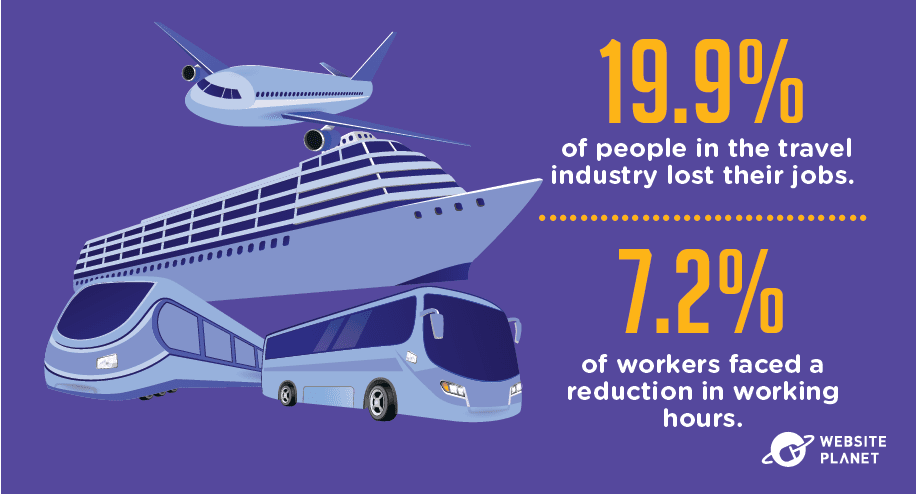 The pandemic put a halt to our freedom and, for many, stopped us from traveling altogether. Unable to leave our homes, it’s no surprise that consumer spending on travel and air travel stopped completely.
In total, the travel industry faced a reduction of 19.9% in employment levels and lost the most working hours of any sector, with a 7.2% reduction in hours every week.
And it’s going to take a while to recover. In the USA, activity amongst the travel and transportation industry is projected to be 87% lower than in April 2019, creating a loss of US$83 billion.
The pandemic put a halt to our freedom and, for many, stopped us from traveling altogether. Unable to leave our homes, it’s no surprise that consumer spending on travel and air travel stopped completely.
In total, the travel industry faced a reduction of 19.9% in employment levels and lost the most working hours of any sector, with a 7.2% reduction in hours every week.
And it’s going to take a while to recover. In the USA, activity amongst the travel and transportation industry is projected to be 87% lower than in April 2019, creating a loss of US$83 billion.
15. Retail Sector’s Future Is Uncertain
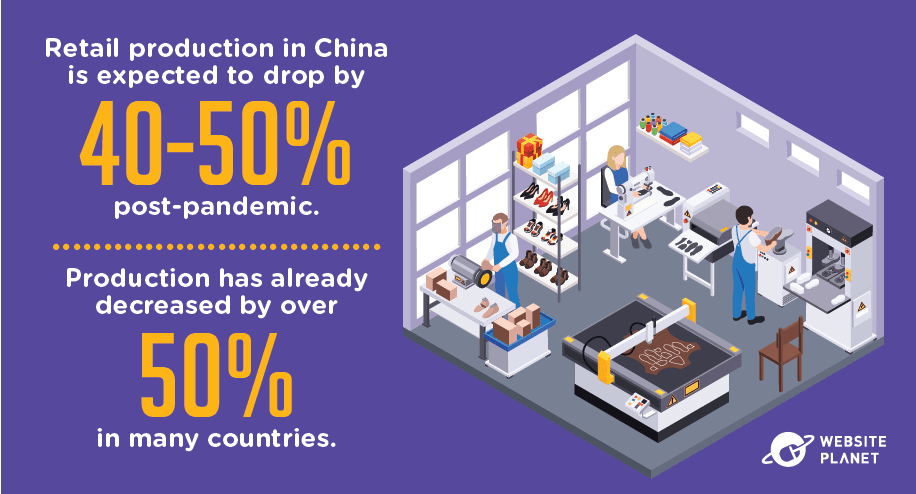 More time spent indoors and forced closure of shops meant the retail industry faced a crippling decline. But both online and offline sales have dropped drastically, forcing many apparel businesses to cut back on production and make savings.
In China, the largest apparel producer, production is projected to be 40-50% lower than pre-pandemic levels. Across many other countries — including the UK, USA, Brazil, Germany, and France, consumption of footwear, apparel, jewelry, and accessories has dropped by more than 50%.
More time spent indoors and forced closure of shops meant the retail industry faced a crippling decline. But both online and offline sales have dropped drastically, forcing many apparel businesses to cut back on production and make savings.
In China, the largest apparel producer, production is projected to be 40-50% lower than pre-pandemic levels. Across many other countries — including the UK, USA, Brazil, Germany, and France, consumption of footwear, apparel, jewelry, and accessories has dropped by more than 50%.
16. The Restaurant Industry Collapsed
 The food and beverage industry was one of the worst affected sectors amidst the pandemic.
Restaurants worldwide saw a 100% reduction in seated diners compared to 2019 due to global shutdowns. While many restaurants turned to creative measures, such as takeaways and delivery services, others could not adapt and were forced to stay closed for the foreseeable future.
The food and beverage industry was one of the worst affected sectors amidst the pandemic.
Restaurants worldwide saw a 100% reduction in seated diners compared to 2019 due to global shutdowns. While many restaurants turned to creative measures, such as takeaways and delivery services, others could not adapt and were forced to stay closed for the foreseeable future.
17. We Cut Back Spending…
 With almost all shops shut, it’s no wonder that consumer spending habits changed. Alongside job losses, working hour reductions, and business closures, consumers were also more inclined to keep their money close to their chest and cut back spending.
Consumer spending is generally down across all industries. However, some felt the effects more than others. In entertainment, food and groceries, household supplies, furniture, and apparel, consumers said their spending would decrease by as much as 75%, leaving many businesses and jobs at risk.
With almost all shops shut, it’s no wonder that consumer spending habits changed. Alongside job losses, working hour reductions, and business closures, consumers were also more inclined to keep their money close to their chest and cut back spending.
Consumer spending is generally down across all industries. However, some felt the effects more than others. In entertainment, food and groceries, household supplies, furniture, and apparel, consumers said their spending would decrease by as much as 75%, leaving many businesses and jobs at risk.
18. …And We Moved to Online Shopping
 For retailers that offer e-commerce websites, COVID-19 actually helped to accelerate growth. Between January 2020 and June 2020, visitors to online retail websites grew from 16 billion to 21 billion.
One survey found that the percentage of consumers purchasing goods online across many categories had increased by 15-30%, keeping many businesses afloat during the pandemic.
For retailers that offer e-commerce websites, COVID-19 actually helped to accelerate growth. Between January 2020 and June 2020, visitors to online retail websites grew from 16 billion to 21 billion.
One survey found that the percentage of consumers purchasing goods online across many categories had increased by 15-30%, keeping many businesses afloat during the pandemic.
19. E-Commerce is Expected to Grow
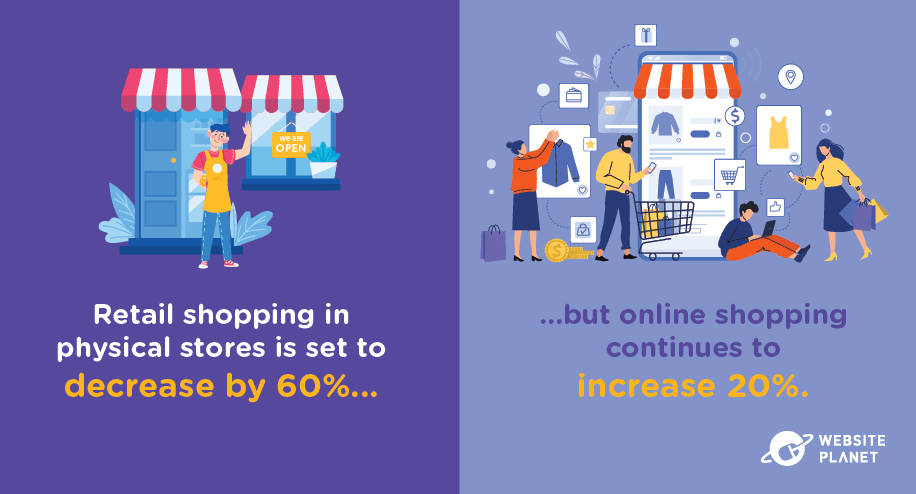 Consumers created an e-commerce boom during the pandemic, and it’s only expected to grow further. Retail shopping in physical stores is set to decrease by as much as 60%. Meanwhile, e-commerce continues to grow at a steady rate of 20%.
Although this helps many businesses scale up and increase profits, it also means the high street and millions of jobs are at risk. The drastic impact this will likely have on employment levels could be crippling for many.
Consumers created an e-commerce boom during the pandemic, and it’s only expected to grow further. Retail shopping in physical stores is set to decrease by as much as 60%. Meanwhile, e-commerce continues to grow at a steady rate of 20%.
Although this helps many businesses scale up and increase profits, it also means the high street and millions of jobs are at risk. The drastic impact this will likely have on employment levels could be crippling for many.
20. The Pandemic Redefined Our Priorities
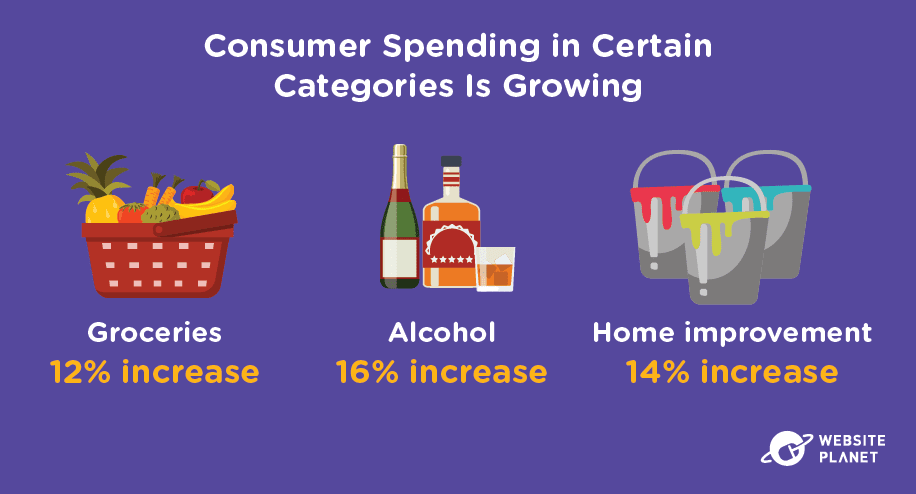 The pandemic not only caused a shift in how we spend, but where we spend too. We turned away from clothing and apparel and towards other categories.
Spending amongst groceries, alcohol, and home improvement goods grew by 12%, 16%, and 14%, respectively. So while other businesses suffered, many sectors actually increased production levels and expanded their workforce.
The pandemic not only caused a shift in how we spend, but where we spend too. We turned away from clothing and apparel and towards other categories.
Spending amongst groceries, alcohol, and home improvement goods grew by 12%, 16%, and 14%, respectively. So while other businesses suffered, many sectors actually increased production levels and expanded their workforce.
21. Big Retailers Saw Massive Growth
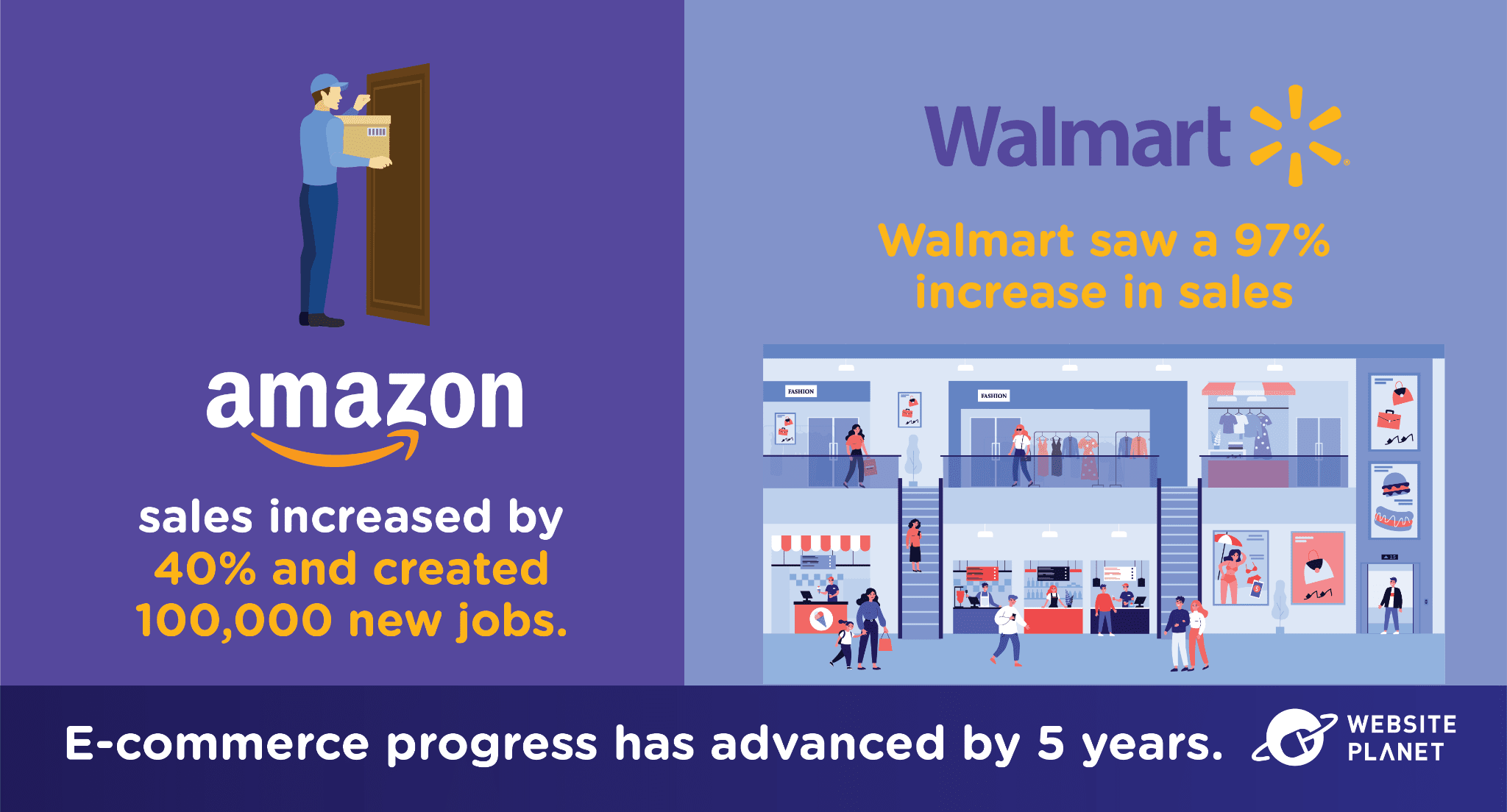 Many big retailers used the pandemic as an opportunity for growth, particularly if they already had sufficient sales through e-commerce avenues.
Amazon, for example, saw a growth of 40% in sales and created 100,000 new jobs. The pandemic also helped Walmart’s e-commerce sales increase by 97%, while Target’s same-day fulfillment services grew by a massive 273%.
According to research, the pandemic has pushed e-commerce progress ahead by 5 years. If businesses can’t make the switch to online soon, it’s likely many more closures, and subsequently, job losses will be on the way.
Many big retailers used the pandemic as an opportunity for growth, particularly if they already had sufficient sales through e-commerce avenues.
Amazon, for example, saw a growth of 40% in sales and created 100,000 new jobs. The pandemic also helped Walmart’s e-commerce sales increase by 97%, while Target’s same-day fulfillment services grew by a massive 273%.
According to research, the pandemic has pushed e-commerce progress ahead by 5 years. If businesses can’t make the switch to online soon, it’s likely many more closures, and subsequently, job losses will be on the way.
22. 6 Sectors Thrived During the Pandemic
 Many businesses struggled to survive during the pandemic, but others faced a very different reality. 6 sectors in particular actually saw an increase in employment.
Telecommunications, computer programming and consultancy, insurance companies, pharmaceutical manufacturing, broadcasting, and other information service businesses were able to adapt to new COVID-19 restrictions and use it as an opportunity to thrive.
In total, telecommunications organizations increased employment levels by over 20%, while computing services increased by a steady 18%. And between both, less than 1 hour a week was lost in working time.
Many businesses struggled to survive during the pandemic, but others faced a very different reality. 6 sectors in particular actually saw an increase in employment.
Telecommunications, computer programming and consultancy, insurance companies, pharmaceutical manufacturing, broadcasting, and other information service businesses were able to adapt to new COVID-19 restrictions and use it as an opportunity to thrive.
In total, telecommunications organizations increased employment levels by over 20%, while computing services increased by a steady 18%. And between both, less than 1 hour a week was lost in working time.
23. Pharmaceutical Companies Increase Profits
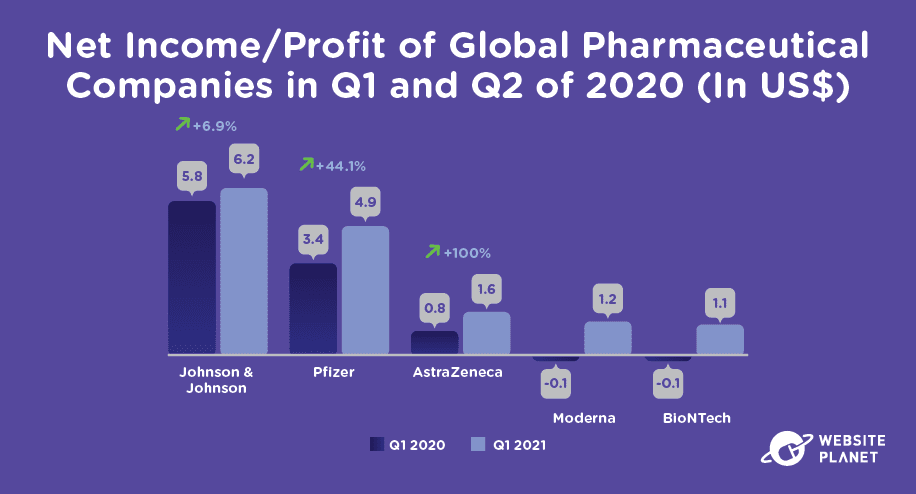 With the spread of COVID-19 imminent, many pharmaceutical companies were under pressure to rapidly innovate and produce vaccines for the global population. As a result, many companies have increased their profits dramatically.
Among the most profitable was Johnson & Johnson, which increased net income by over US$5 billion in both Q1 and Q2 of 2020. But smaller, less-known companies like Pfizer have also increased net income by a massive 44% due to the vaccine roll-out.
With the spread of COVID-19 imminent, many pharmaceutical companies were under pressure to rapidly innovate and produce vaccines for the global population. As a result, many companies have increased their profits dramatically.
Among the most profitable was Johnson & Johnson, which increased net income by over US$5 billion in both Q1 and Q2 of 2020. But smaller, less-known companies like Pfizer have also increased net income by a massive 44% due to the vaccine roll-out.
24. Jobs Are Opening Once Again
 Not all is lost. As we begin to see life return to “normal” once again, the employment sector is also starting its recovery.
Across the hospitality sector especially, job openings are surging. In the USA, the number of available job postings in hospitality reached 10 million in June 2021 — up an extra million from the month before.
But fulfilling positions is another struggle. Around 4 million people quit their jobs in April in the USA, which is a strong indicator many believe they can find better positions elsewhere.
Not all is lost. As we begin to see life return to “normal” once again, the employment sector is also starting its recovery.
Across the hospitality sector especially, job openings are surging. In the USA, the number of available job postings in hospitality reached 10 million in June 2021 — up an extra million from the month before.
But fulfilling positions is another struggle. Around 4 million people quit their jobs in April in the USA, which is a strong indicator many believe they can find better positions elsewhere.
25. Travel Will Take Off
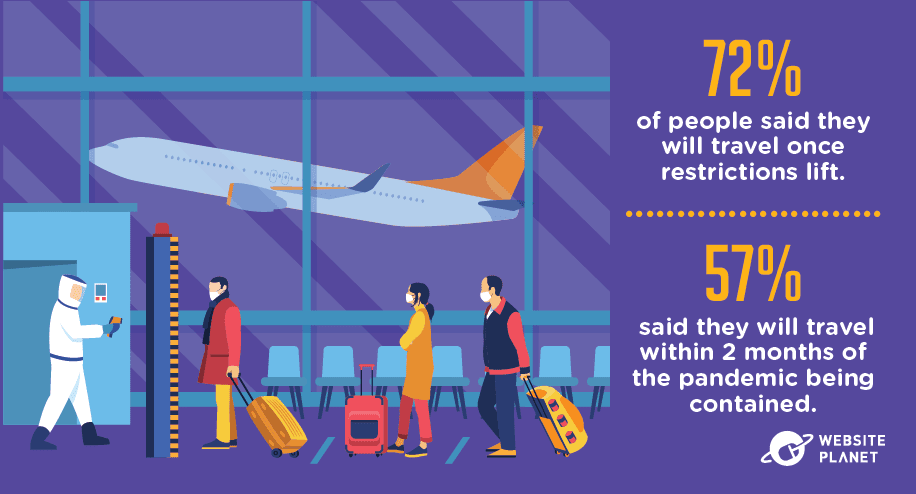 As restrictions ease, more and more of us are leaving our homes and countries and heading back to our favorite vacation spots.
In a recent survey, 72% of people said they would travel as soon as they’re able to meet friends and family. And 57% said they would travel within 2 months of the pandemic being contained.
However, with many airlines decreasing their aircraft capacity and laying off employees, there are question marks around whether the travel industry will cope under the looming pressure.
As restrictions ease, more and more of us are leaving our homes and countries and heading back to our favorite vacation spots.
In a recent survey, 72% of people said they would travel as soon as they’re able to meet friends and family. And 57% said they would travel within 2 months of the pandemic being contained.
However, with many airlines decreasing their aircraft capacity and laying off employees, there are question marks around whether the travel industry will cope under the looming pressure.
26. Certain Sectors Are Still Facing Shortages
 Production numbers and employment levels are increasing among many sectors, but shortages are still at play. The automotive industry was deeply affected by COVID-19 and is still feeling the effects nearly 18 months later.
In the UK, the first half of 2021 saw a drop in production levels of 38.4% (based on a 5-year average) due to lockdowns. In terms of new car registrations, the UK lost 29% due to COVID-19.
This is consistent in many other countries around the world. New car registrations fell by 19% in Germany, while Italy saw a greater decline of 28%.
Production numbers and employment levels are increasing among many sectors, but shortages are still at play. The automotive industry was deeply affected by COVID-19 and is still feeling the effects nearly 18 months later.
In the UK, the first half of 2021 saw a drop in production levels of 38.4% (based on a 5-year average) due to lockdowns. In terms of new car registrations, the UK lost 29% due to COVID-19.
This is consistent in many other countries around the world. New car registrations fell by 19% in Germany, while Italy saw a greater decline of 28%.
27. Some Businesses Won’t Recover for a Long Time
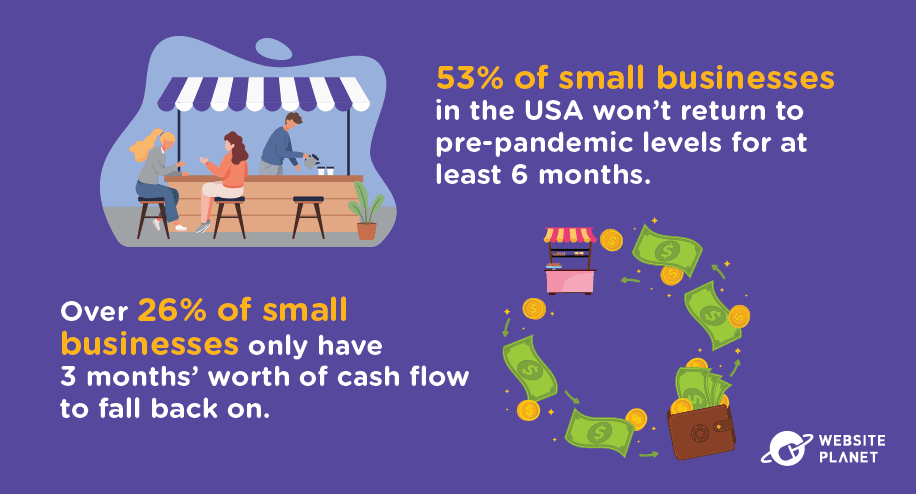 In the USA, 53% of small businesses won’t see operations return to pre-pandemic levels for at least 6 months, while many are worried they won’t recover at all.
On average, only 26% of small American businesses have 3 months’ worth of funds to see them through to the other side of the pandemic. With little cash flow and reduced production levels, the road to recovery looks long for many.
In the USA, 53% of small businesses won’t see operations return to pre-pandemic levels for at least 6 months, while many are worried they won’t recover at all.
On average, only 26% of small American businesses have 3 months’ worth of funds to see them through to the other side of the pandemic. With little cash flow and reduced production levels, the road to recovery looks long for many.
COVID-19 Changed the Way People Work & Left Many Unemployed
COVID-19 temporarily changed the world of work, forcing employees out of their offices and into remote working. But not everyone was able to adapt to WFH, leaving many businesses and employees at risk of unemployment.28. Employees Forced to Work at Home
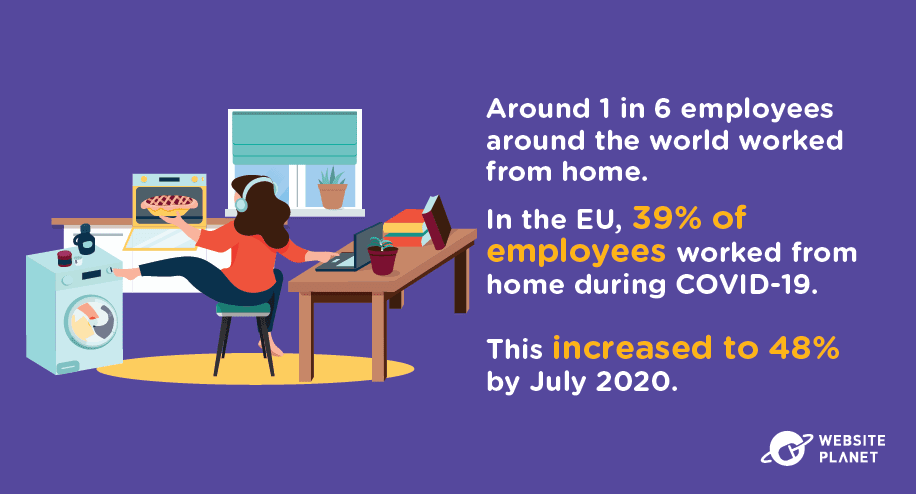 With restrictions limiting activity worldwide, the majority of the global workforce was forced to work from home. Around 1 in 6 employees worked from home globally.
In the EU, around 39% of employees were WFH – rising to 48% by July 2020. For many, this was a complete shift in the usual way of working. Prior to the pandemic, fewer than 1 in 20 employees regularly worked from home.
With restrictions limiting activity worldwide, the majority of the global workforce was forced to work from home. Around 1 in 6 employees worked from home globally.
In the EU, around 39% of employees were WFH – rising to 48% by July 2020. For many, this was a complete shift in the usual way of working. Prior to the pandemic, fewer than 1 in 20 employees regularly worked from home.
29. Working From Home Linked to Education Level
 The pandemic forced many people out of office. However, those with a higher level of attainment were more likely to be working from home than low-skilled workers.
Over 60% of those working from home had third-level degrees, compared with less than 30% of employees with lower levels of attainment.
And younger people also saw a massive increase in working from home, with the pandemic increasing access to teleworking and removing the status-related aspect of home working.
The pandemic forced many people out of office. However, those with a higher level of attainment were more likely to be working from home than low-skilled workers.
Over 60% of those working from home had third-level degrees, compared with less than 30% of employees with lower levels of attainment.
And younger people also saw a massive increase in working from home, with the pandemic increasing access to teleworking and removing the status-related aspect of home working.
30. Increase in Job Postings Requesting Working From Home
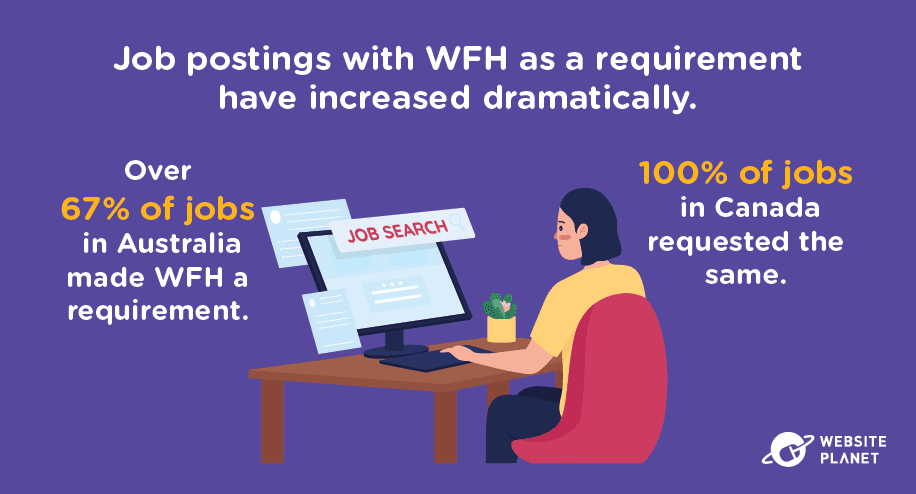 As a result of the pandemic, the number of job postings making “working from home” a requirement has significantly increased.
In Australia and Canada, job postings with work-from-home arrangements increased by 67% and 100%, respectively. Whether in response to the pandemic or not, this is a strong indicator that the working world is shifting, with remote working being a key driver for change.
As a result of the pandemic, the number of job postings making “working from home” a requirement has significantly increased.
In Australia and Canada, job postings with work-from-home arrangements increased by 67% and 100%, respectively. Whether in response to the pandemic or not, this is a strong indicator that the working world is shifting, with remote working being a key driver for change.
31. Online Job Postings Declined Overall
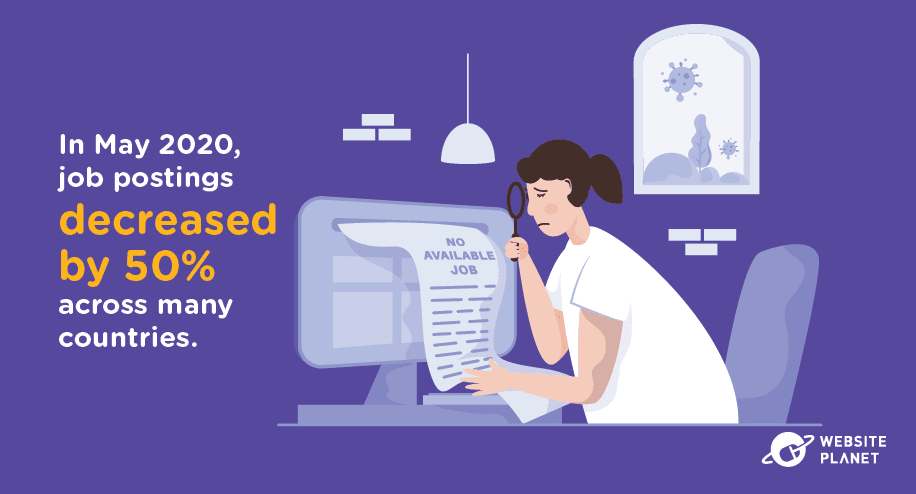 With many businesses closed or struggling to continue operations, it’s not surprising that the overall number of job postings declined during the pandemic.
By early May 2020, job postings had decreased by over 50% in many countries, including the UK, Canada, Australia, and the USA. Not only were employees laid off work either temporarily or permanently, but vacancies were also not available to fill.
Even in December 2020, the sharp decline in online job vacancies was still evident in the UK and the USA.
With many businesses closed or struggling to continue operations, it’s not surprising that the overall number of job postings declined during the pandemic.
By early May 2020, job postings had decreased by over 50% in many countries, including the UK, Canada, Australia, and the USA. Not only were employees laid off work either temporarily or permanently, but vacancies were also not available to fill.
Even in December 2020, the sharp decline in online job vacancies was still evident in the UK and the USA.
32. COVID-19 Favored Skilled Workers…
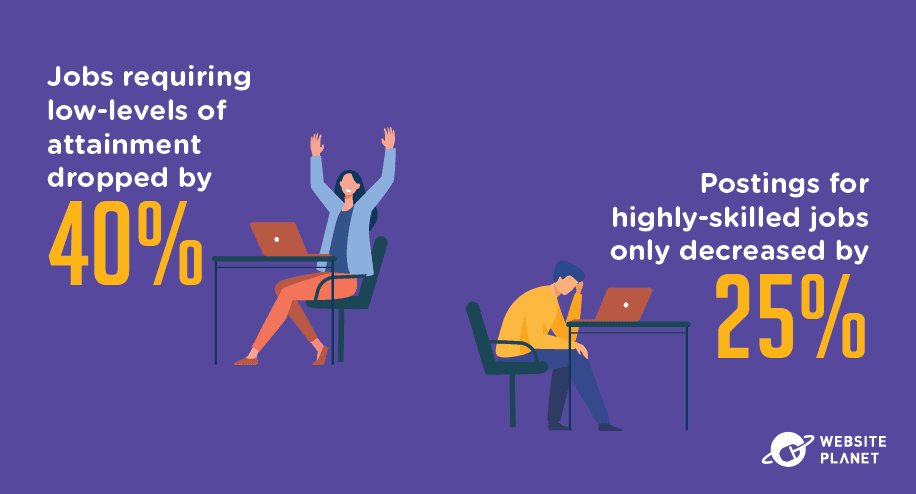 Of the job vacancies that remained, many demanded a higher skill set.
The number of job postings requiring lower levels of attainment, such as secondary or lower, fell by around 40%. But for more highly skilled workers with a degree qualification or above, this only dropped by about 25%.
Since low-skilled, low-educated workers were more likely to be forced out of employment during the pandemic, this has only added more pressure for many. Without employment or the possibility of applying for new vacancies, it’s likely the employment gap will be felt for a long time to come.
Of the job vacancies that remained, many demanded a higher skill set.
The number of job postings requiring lower levels of attainment, such as secondary or lower, fell by around 40%. But for more highly skilled workers with a degree qualification or above, this only dropped by about 25%.
Since low-skilled, low-educated workers were more likely to be forced out of employment during the pandemic, this has only added more pressure for many. Without employment or the possibility of applying for new vacancies, it’s likely the employment gap will be felt for a long time to come.
33. …And Left Millions Unemployed
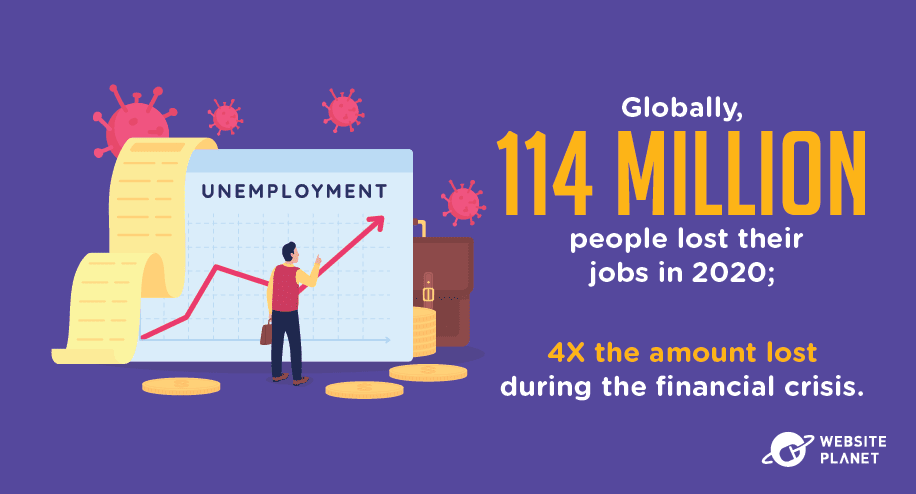 Millions of people around the world were left unemployed as a result of COVID-19. Increasing restrictions put a halt on operations and production lines for many businesses, leaving them no option but to cut back their workforce.
Globally, it’s estimated that 114 million people lost their jobs in 2020 alone, which is 4 times higher than the financial crisis in 2009. In the accommodation sector, around 1.1 million jobs were lost, which is the highest of any industry.
Millions of people around the world were left unemployed as a result of COVID-19. Increasing restrictions put a halt on operations and production lines for many businesses, leaving them no option but to cut back their workforce.
Globally, it’s estimated that 114 million people lost their jobs in 2020 alone, which is 4 times higher than the financial crisis in 2009. In the accommodation sector, around 1.1 million jobs were lost, which is the highest of any industry.
34. New Job Starters in Many Countries Declined…
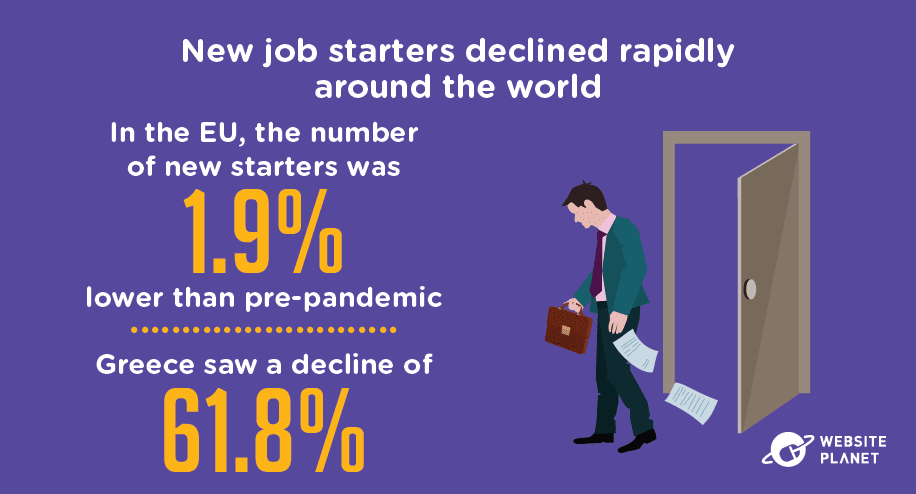 Fewer job postings naturally put a halt on new starters to the labor market around the globe.
In total, across the EU, the number of new starters was around 1.9% lower in the first quarter of 2020 than in the last quarter of 2019.
Some countries also experienced a more rapid decline than others, with Greece taking a 61.8% hit. In Hungary, the effects were less severe, only dropping by around 0.8% — clearly demonstrating how diverse the impact of COVID-19 has been.
Fewer job postings naturally put a halt on new starters to the labor market around the globe.
In total, across the EU, the number of new starters was around 1.9% lower in the first quarter of 2020 than in the last quarter of 2019.
Some countries also experienced a more rapid decline than others, with Greece taking a 61.8% hit. In Hungary, the effects were less severe, only dropping by around 0.8% — clearly demonstrating how diverse the impact of COVID-19 has been.
35. …While Many Also Left Their Jobs
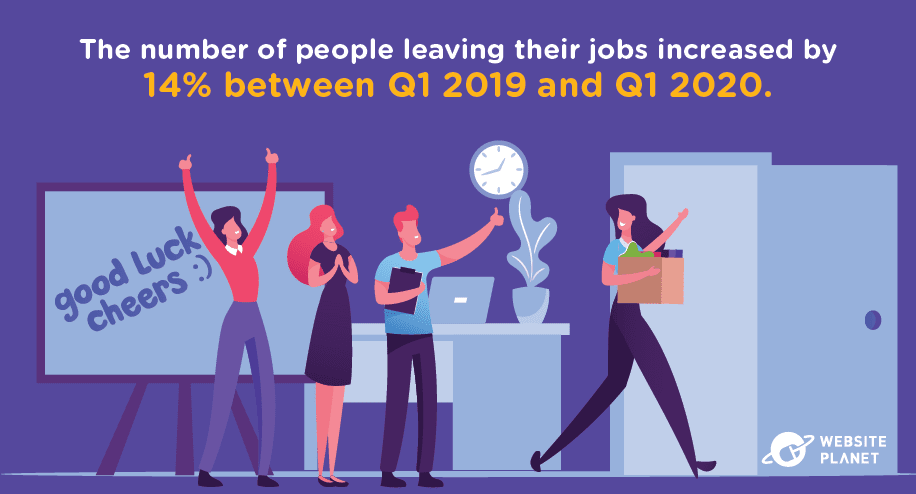 Whether hoping to find better positions elsewhere or forced to leave their employment, thousands of employees left their jobs during 2020.
Between the first quarter of 2019 and 2020, the number of people leaving their jobs increased by over 14% across the EU.
However, many were still looking for employment, with “jobs hiring near me” being a peak search term in the first and second quarter of 2020 (especially in the US). In fact, searches relating to “jobs hiring near me full-time” increased by 3,600% last year. The fight for employment continues.
Whether hoping to find better positions elsewhere or forced to leave their employment, thousands of employees left their jobs during 2020.
Between the first quarter of 2019 and 2020, the number of people leaving their jobs increased by over 14% across the EU.
However, many were still looking for employment, with “jobs hiring near me” being a peak search term in the first and second quarter of 2020 (especially in the US). In fact, searches relating to “jobs hiring near me full-time” increased by 3,600% last year. The fight for employment continues.
36. Women Experienced More Employment Loss
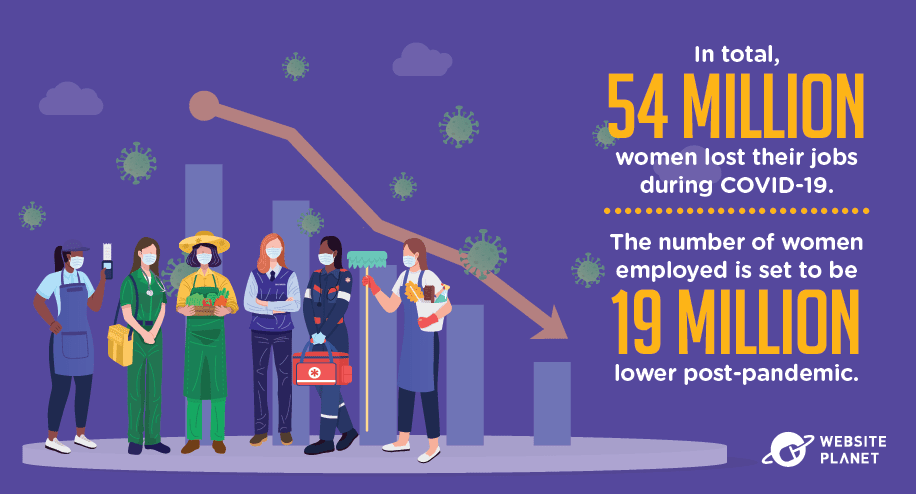 The impact of COVID-19 on female employment has been severe. In total, 54 million women lost their jobs.
And while male employment is set to recover quite quickly, the future doesn’t look so bright for female employees. The number of women in employment is still estimated to be 19 million less than in 2019, only widening the gender equality gap.
The impact of COVID-19 on female employment has been severe. In total, 54 million women lost their jobs.
And while male employment is set to recover quite quickly, the future doesn’t look so bright for female employees. The number of women in employment is still estimated to be 19 million less than in 2019, only widening the gender equality gap.
37. COVID-19 Is Pushing Women into Poverty
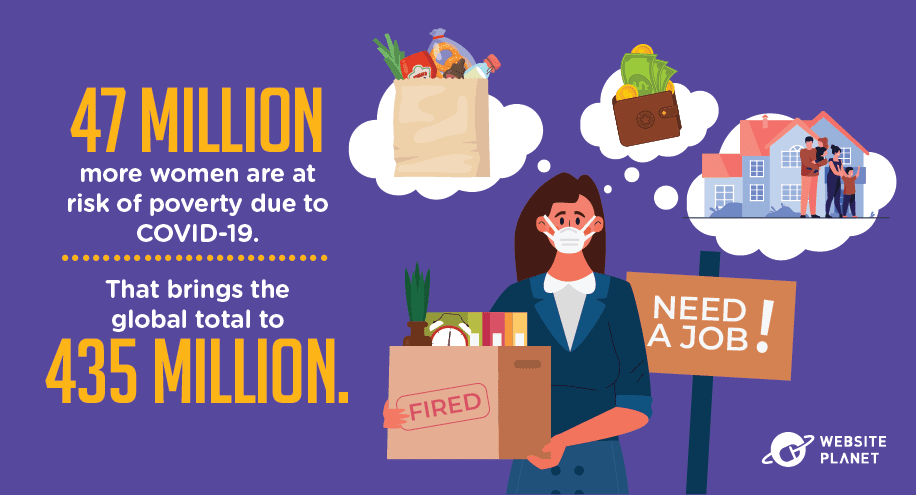 Not only has COVID-19 forced thousands of women around the world out of employment, but it’s actually pushing them into poverty.
The pandemic is expected to put 47 million more women at risk of poverty, bringing the total to a staggering 435 million worldwide. And it’s not set to slow down anytime soon. By 2030, there will be 121 women in poverty for every 100 men.
Not only has COVID-19 forced thousands of women around the world out of employment, but it’s actually pushing them into poverty.
The pandemic is expected to put 47 million more women at risk of poverty, bringing the total to a staggering 435 million worldwide. And it’s not set to slow down anytime soon. By 2030, there will be 121 women in poverty for every 100 men.
38. Unemployment Has Come at a High Cost for Women
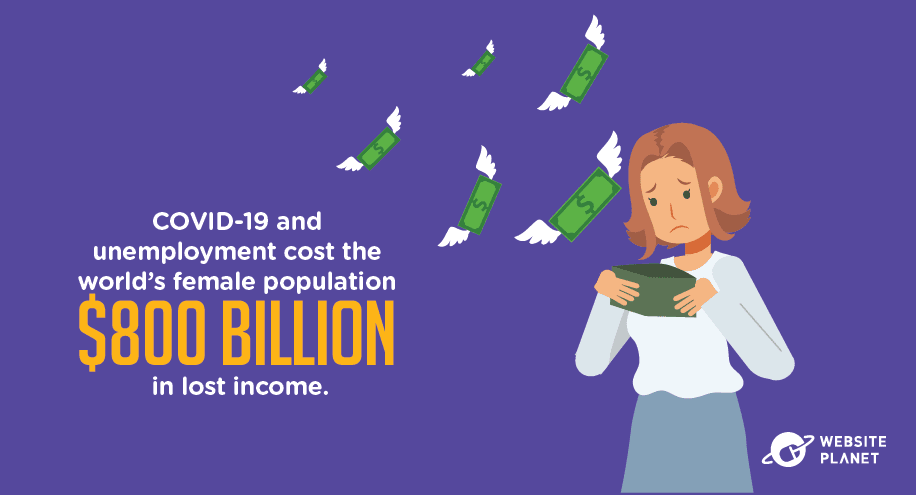 Women lost their jobs at a much faster rate than men during the pandemic. Overrepresented in low-income, low-skilled jobs, and in the worst-hit sectors like accommodation and retail, women truly felt the impact on the labor market.
In total, unemployment across the female population has cost $800 billion in lost income. The knock-on effects are even worse, with 1 in 6 women of color in the USA facing food insecurity due to the pandemic.
Women lost their jobs at a much faster rate than men during the pandemic. Overrepresented in low-income, low-skilled jobs, and in the worst-hit sectors like accommodation and retail, women truly felt the impact on the labor market.
In total, unemployment across the female population has cost $800 billion in lost income. The knock-on effects are even worse, with 1 in 6 women of color in the USA facing food insecurity due to the pandemic.
39. Young People Forced Out of Work
 Reduced operations and production forced many out of the door, and young people were the first to go.
When COVID-19 hit its peak, around 178 million young people aged 15-24 were employed in the hardest-hit sectors. That equates to 1 in 4 of the young global workforce.
Between February and July 2020, around 1 in 4 young adults in the USA were unemployed, increasing 290% from the previous year. Alongside limited education and increased social isolation, the pandemic certainly took its toll on the young population. It is likely the effects will be felt for many years to come.
Reduced operations and production forced many out of the door, and young people were the first to go.
When COVID-19 hit its peak, around 178 million young people aged 15-24 were employed in the hardest-hit sectors. That equates to 1 in 4 of the young global workforce.
Between February and July 2020, around 1 in 4 young adults in the USA were unemployed, increasing 290% from the previous year. Alongside limited education and increased social isolation, the pandemic certainly took its toll on the young population. It is likely the effects will be felt for many years to come.
40. Young People in North Africa Most Vulnerable
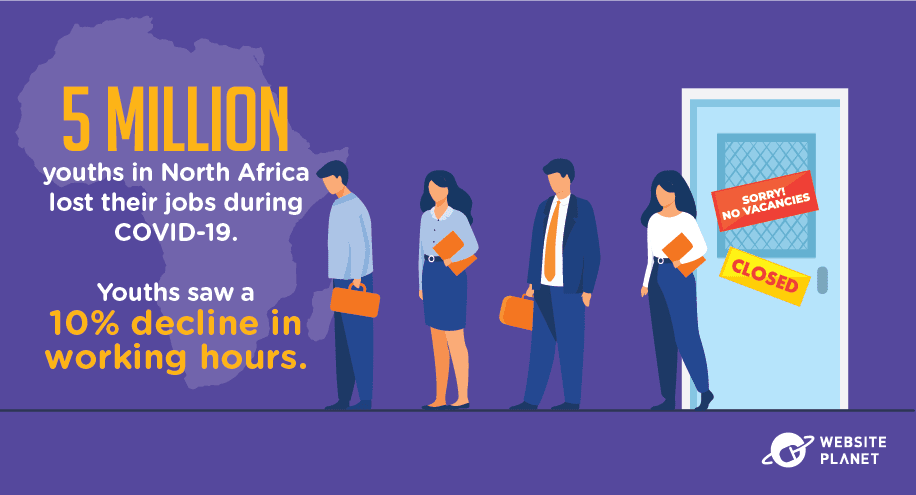 Prior to COVID-19, North Africa had the highest youth unemployment rate globally, with 27% of the youth population out of work.
Since the pandemic, things have gotten worse. Labor underutilization in youths has increased to over 50%, which is the highest of any country in the world. With supply outweighing demand, and poverty ever-increasing, North Africa is struggling.
Across all age groups, North Africa lost the equivalent of 5 million jobs in 2020, caused by a decline of 10% in total working hours.
Prior to COVID-19, North Africa had the highest youth unemployment rate globally, with 27% of the youth population out of work.
Since the pandemic, things have gotten worse. Labor underutilization in youths has increased to over 50%, which is the highest of any country in the world. With supply outweighing demand, and poverty ever-increasing, North Africa is struggling.
Across all age groups, North Africa lost the equivalent of 5 million jobs in 2020, caused by a decline of 10% in total working hours.
41. Long-Lasting Impact of Low Youth Employment
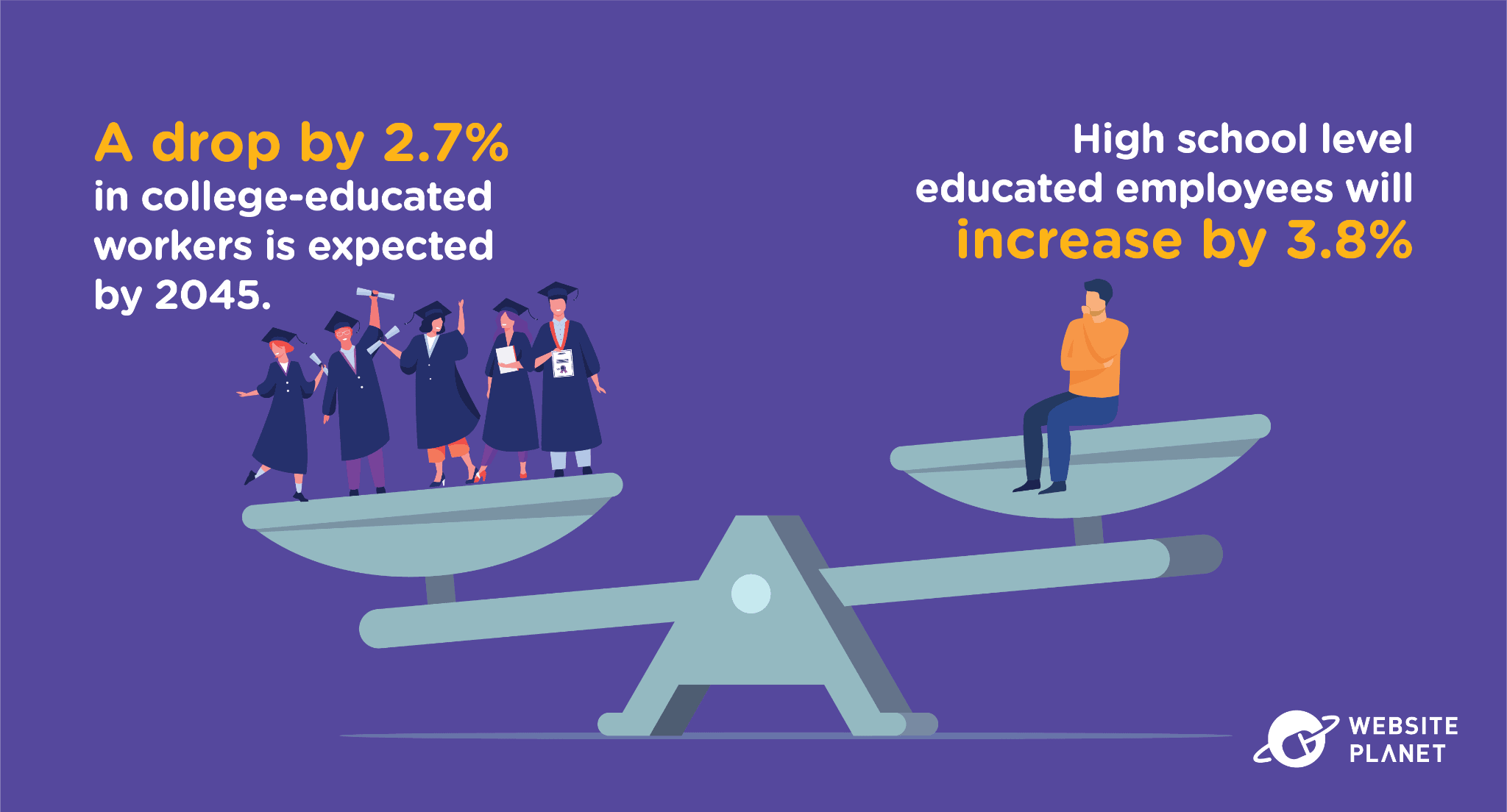 The youths of today are the global workforce of tomorrow, and COVID-19 restrictions forced many out of work or into online learning. The potential implications on the future of the labor job market could be severe.
As a result of learning disruptions, it’s estimated that the number of college-educated workers in 2045 will drop by 2.7%, while those educated to a high school level or lower will increase by 3.8%.
Since higher education is linked to increased earnings, productivity and worldwide income will probably significantly deteriorate in the years to come, which could drastically affect our global economy.
The youths of today are the global workforce of tomorrow, and COVID-19 restrictions forced many out of work or into online learning. The potential implications on the future of the labor job market could be severe.
As a result of learning disruptions, it’s estimated that the number of college-educated workers in 2045 will drop by 2.7%, while those educated to a high school level or lower will increase by 3.8%.
Since higher education is linked to increased earnings, productivity and worldwide income will probably significantly deteriorate in the years to come, which could drastically affect our global economy.
42. Unemployment Expected to Rise Significantly
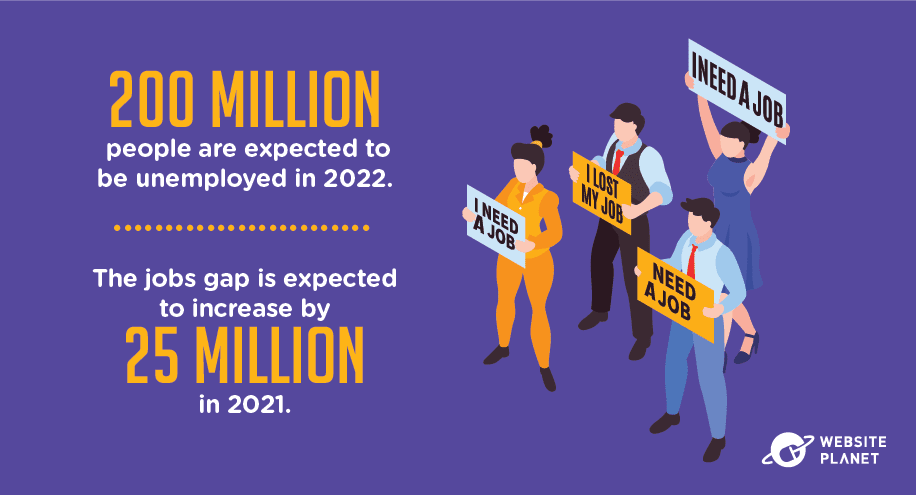 Although the global job market is showing signs of recovery, levels of unemployment remain high.
Over 200 million people are expected to be unemployed in 2022, increasing from 187 million in 2019. Poverty, low incomes, and a lack of job vacancies are more significant concerns for the global economy than ever before.
The jobs gap is also expected to rise to 75 million in 2021. While it is predicted to drop to 23 million in 2022, this is still drastically higher than pre-pandemic levels.
Although the global job market is showing signs of recovery, levels of unemployment remain high.
Over 200 million people are expected to be unemployed in 2022, increasing from 187 million in 2019. Poverty, low incomes, and a lack of job vacancies are more significant concerns for the global economy than ever before.
The jobs gap is also expected to rise to 75 million in 2021. While it is predicted to drop to 23 million in 2022, this is still drastically higher than pre-pandemic levels.
43. More Americans Filing for Unemployment
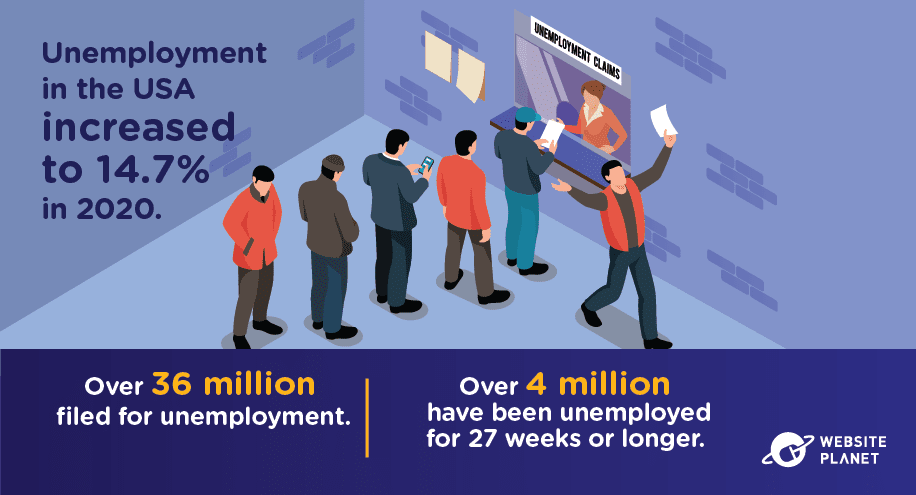 Unemployment in the USA in April 2020 increased to 14.7%, which is the highest level since the Second World War and one of the highest in the world. In the first 2 months of 2020, over 36 million Americans filed for unemployment.
More than 4 million unemployed people in the US have been out of work for 27 weeks or longer, highlighting just how difficult re-entering the labor job market is post-pandemic.
Unemployment in the USA in April 2020 increased to 14.7%, which is the highest level since the Second World War and one of the highest in the world. In the first 2 months of 2020, over 36 million Americans filed for unemployment.
More than 4 million unemployed people in the US have been out of work for 27 weeks or longer, highlighting just how difficult re-entering the labor job market is post-pandemic.
44. UK Employment Is Also Vulnerable
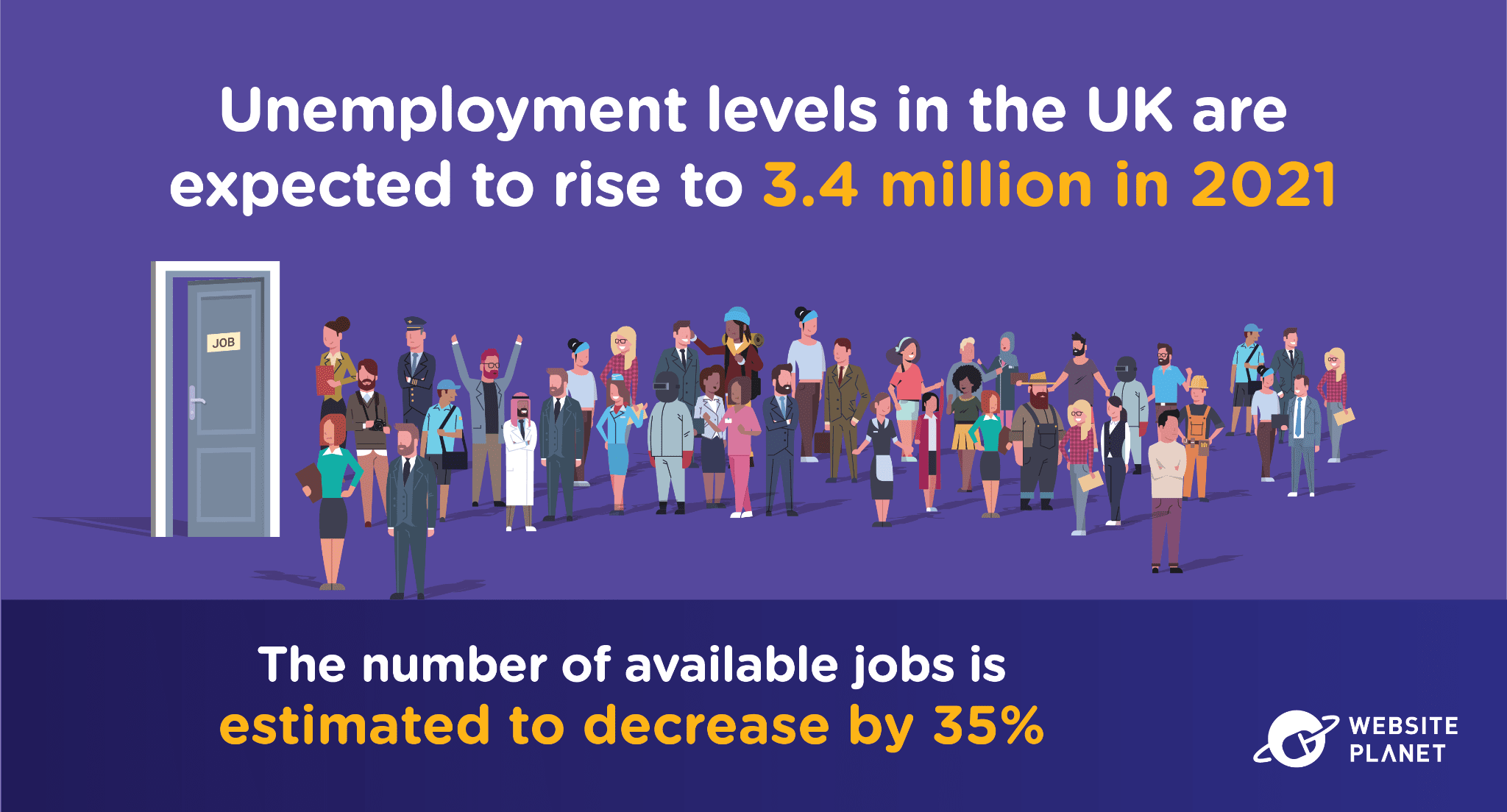 UK employees have also suffered greatly. In 2021, unemployment levels are expected to peak at 3.4 million, which is an increase of 2.3 million.
The impact of a jobless population on the UK economy is worrying, not only for the UK, but also for the rest of the world. The number of available jobs is expected to shrink by at least 35% post-pandemic.
UK employees have also suffered greatly. In 2021, unemployment levels are expected to peak at 3.4 million, which is an increase of 2.3 million.
The impact of a jobless population on the UK economy is worrying, not only for the UK, but also for the rest of the world. The number of available jobs is expected to shrink by at least 35% post-pandemic.
45. Asian GDP Levels Slump
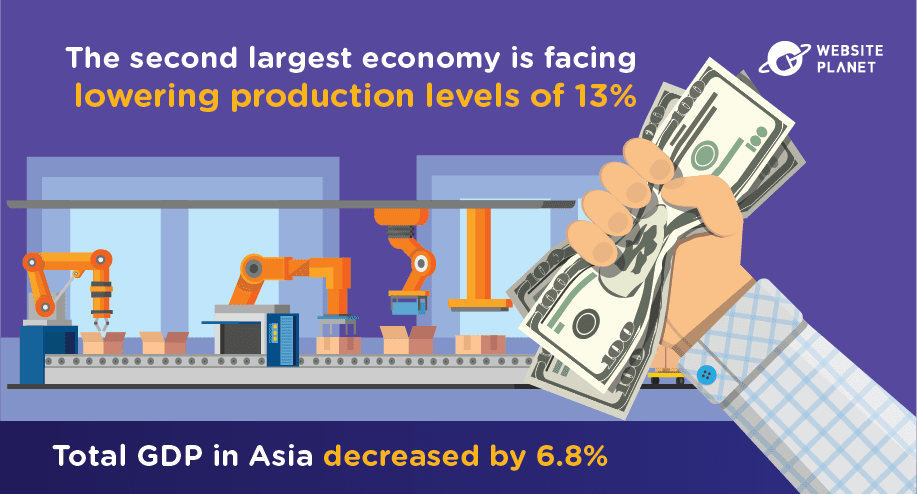 Asia is the world’s second-largest economy, but national shutdowns put a halt on production levels, travel, and shipping — and pushed thousands out of work. In China, production levels dropped by over 13% in the first 2 months of 2020, which is the highest in a decade.
Economic effects were felt by the entire region, however. In total, GDP decreased by 6.8%. And back in April 2020, the IMF warned that Asian economies would see no growth at all this year. While the region has managed to shield itself somewhat, the knock-on effects of zero growth on employment and new job vacancies will be anything but positive.
Asia is the world’s second-largest economy, but national shutdowns put a halt on production levels, travel, and shipping — and pushed thousands out of work. In China, production levels dropped by over 13% in the first 2 months of 2020, which is the highest in a decade.
Economic effects were felt by the entire region, however. In total, GDP decreased by 6.8%. And back in April 2020, the IMF warned that Asian economies would see no growth at all this year. While the region has managed to shield itself somewhat, the knock-on effects of zero growth on employment and new job vacancies will be anything but positive.
Governments & Workplaces Have Offered Support
Governments worldwide stepped in to provide a safety net for the global job market, offering financial and workplace support to thousands of employees. But doing so came at a price for the global economy.46. Governments Promised to Minimize Economic Impact
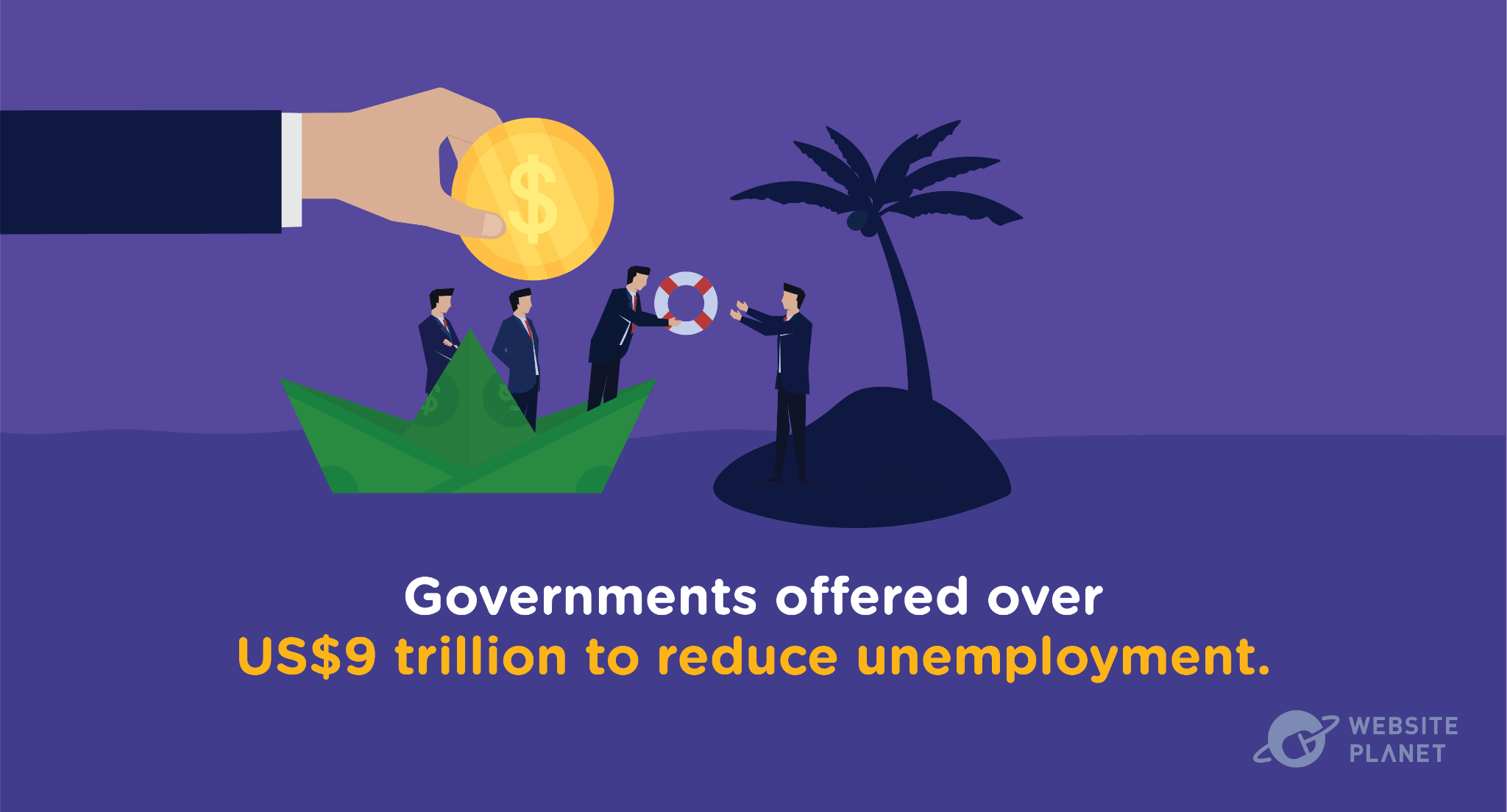 In response to COVID-19, governments around the world introduced a variety of packages to protect the labor economy. These included wage subsidiaries, job retention schemes, increased sick leave, and childcare cover expenses.
By October 2020, governments had promised over US$9 trillion in stimulus packages to reduce unemployment levels and minimize the impact of the pandemic. Although many countries immediately revised or introduced new schemes to protect workers, the packages on offer varied greatly between locations and — typically — favored formal, full-time employees over others.
In response to COVID-19, governments around the world introduced a variety of packages to protect the labor economy. These included wage subsidiaries, job retention schemes, increased sick leave, and childcare cover expenses.
By October 2020, governments had promised over US$9 trillion in stimulus packages to reduce unemployment levels and minimize the impact of the pandemic. Although many countries immediately revised or introduced new schemes to protect workers, the packages on offer varied greatly between locations and — typically — favored formal, full-time employees over others.
47. Employers Extended Sick Leave
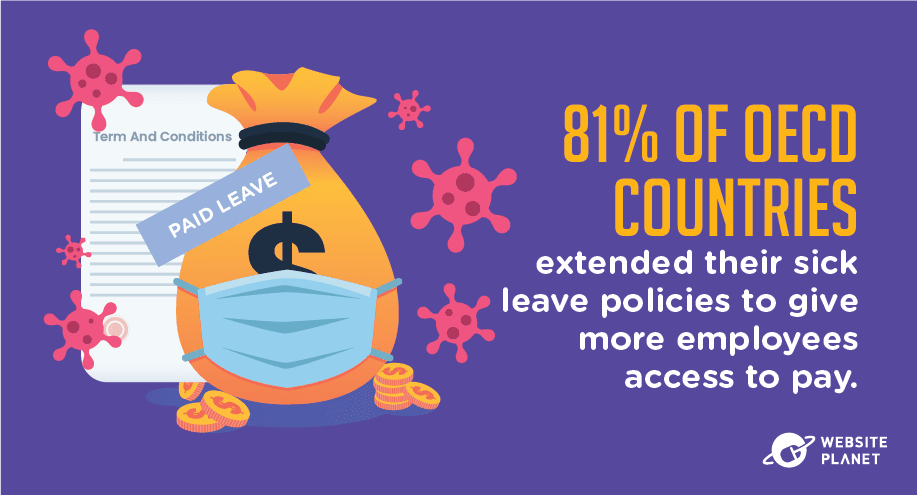 Paid sick leave has been one of the most critical buffers for employment and income protection during the pandemic. In total, 81% of OECD countries extended their sick pay packages.
In countries where employees would not usually receive pay, they were entitled to full sick leave. Most countries extended their sick pay policies to account for more days. Others also provided cover for workers forced to quarantine, and without any waiting period.
Paid sick leave has been one of the most critical buffers for employment and income protection during the pandemic. In total, 81% of OECD countries extended their sick pay packages.
In countries where employees would not usually receive pay, they were entitled to full sick leave. Most countries extended their sick pay policies to account for more days. Others also provided cover for workers forced to quarantine, and without any waiting period.
48. Liquidity Relief for Firms
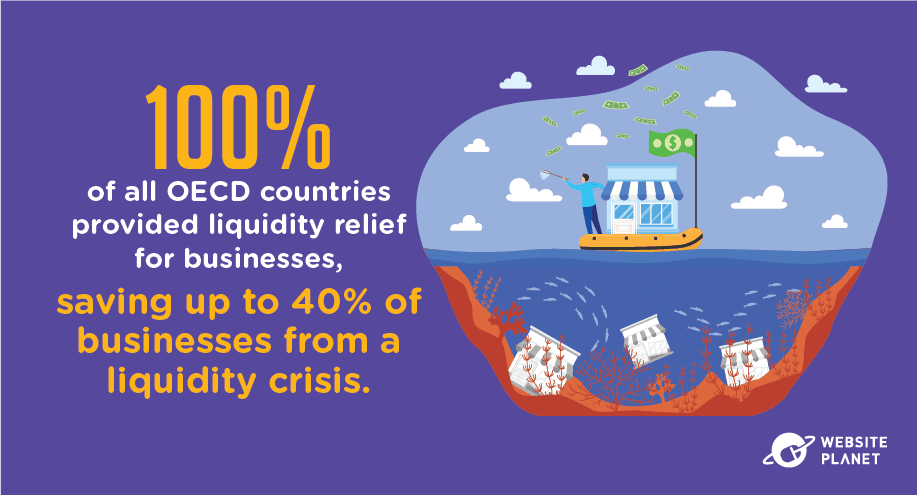 Across all OECD countries, 100% introduced liquidity relief for firms to reduce the risk of crisis due to forced lockdowns and restrictions. These measures included tax deferrals, direct subsidies, employment grants, and even direct liquidity contributions.
The OECD estimates that had liquidity relief not been in place, 20% of firms would have faced a liquidity crisis after 1 month and a further 40% after 3 months — leaving an even greater number of the global workforce unemployed.
Across all OECD countries, 100% introduced liquidity relief for firms to reduce the risk of crisis due to forced lockdowns and restrictions. These measures included tax deferrals, direct subsidies, employment grants, and even direct liquidity contributions.
The OECD estimates that had liquidity relief not been in place, 20% of firms would have faced a liquidity crisis after 1 month and a further 40% after 3 months — leaving an even greater number of the global workforce unemployed.
49. Increased Access to Job Retention Schemes
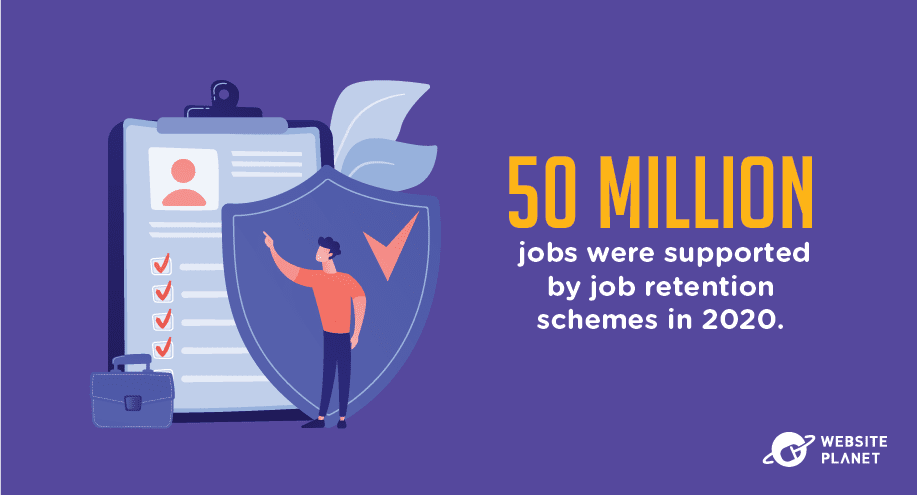 Many governments introduced job retention schemes, which allowed employers to cut back their employees’ hours or temporarily lay off their employees while receiving income support from the government.
By May 2020, around 50 million jobs were supported by job retention schemes — twice as many as during the financial crisis. If no packages were in place, these employees would likely have been forced out of work permanently. Not to mention the many unfulfilled job vacancies once production began to return to pre-pandemic levels.
Many governments introduced job retention schemes, which allowed employers to cut back their employees’ hours or temporarily lay off their employees while receiving income support from the government.
By May 2020, around 50 million jobs were supported by job retention schemes — twice as many as during the financial crisis. If no packages were in place, these employees would likely have been forced out of work permanently. Not to mention the many unfulfilled job vacancies once production began to return to pre-pandemic levels.
50. USA Ramped Up Short-Time Work Scheme
 The USA already had a short-time work scheme in place, but they significantly extended their policy to subsidize more employees and encourage USA states to rethink their approach.
The government now funds 100% of all payments through the STC scheme for states that already have an STC policy in place, and 50% for all states that introduced a new one.
They also introduced an employee retention tax credit scheme available for employers who have seen more than a 50% drop in sales due to the pandemic. This funded 50% of all refundable tax credits for qualifying firms.
The USA already had a short-time work scheme in place, but they significantly extended their policy to subsidize more employees and encourage USA states to rethink their approach.
The government now funds 100% of all payments through the STC scheme for states that already have an STC policy in place, and 50% for all states that introduced a new one.
They also introduced an employee retention tax credit scheme available for employers who have seen more than a 50% drop in sales due to the pandemic. This funded 50% of all refundable tax credits for qualifying firms.
51. Germany Simplified and Extended Access to Support
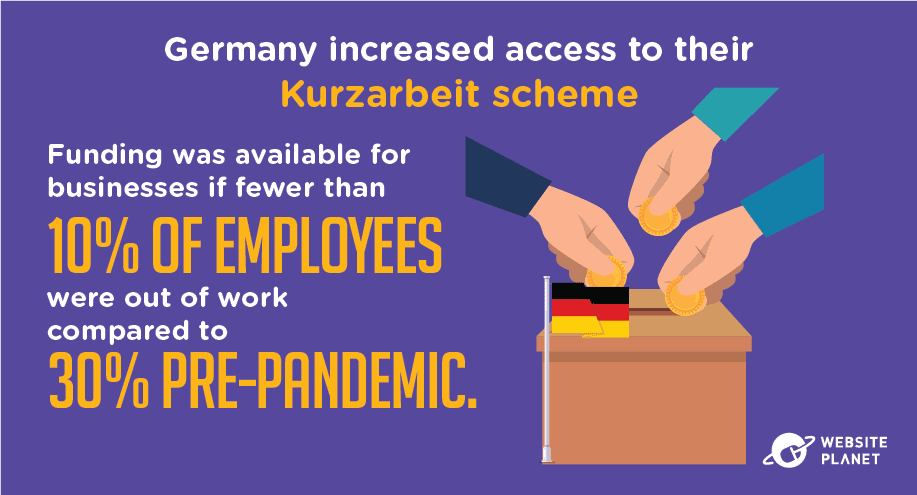 The German government simplified access to their Kurzarbeit scheme, allowing firms to request support if less than 10% of their employees were on reduced hours compared to 30% pre-pandemic.
They also removed restrictions on taking up another job while part of the STC scheme and increased statutory pay to cover lost earnings by up to 80%. While Germany already included temporary and contracted workers in their initial scheme, they increased access for agency workers at the beginning of the pandemic, saving thousands of jobs.
The German government simplified access to their Kurzarbeit scheme, allowing firms to request support if less than 10% of their employees were on reduced hours compared to 30% pre-pandemic.
They also removed restrictions on taking up another job while part of the STC scheme and increased statutory pay to cover lost earnings by up to 80%. While Germany already included temporary and contracted workers in their initial scheme, they increased access for agency workers at the beginning of the pandemic, saving thousands of jobs.
52. Japan Expanded Coverage of Job Retention Schemes
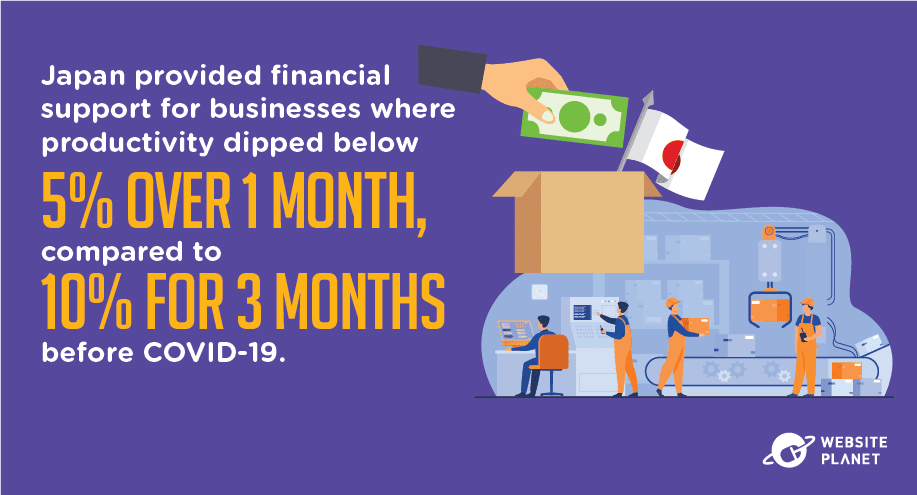 Pre-pandemic, production had to decrease by 10% for more than 3 months in Japan for employers to qualify for any support. In response to the pandemic, Japan cut back this requirement to 5% over 1 month, saving many businesses from falling into debt once restrictions came into play.
They also introduced a new scheme to cover employees whose workplaces had not applied for the scheme and therefore did not benefit from any subsidy. These employees were entitled to up to 80% of their total earnings, preventing many from a drastic loss in income.
Pre-pandemic, production had to decrease by 10% for more than 3 months in Japan for employers to qualify for any support. In response to the pandemic, Japan cut back this requirement to 5% over 1 month, saving many businesses from falling into debt once restrictions came into play.
They also introduced a new scheme to cover employees whose workplaces had not applied for the scheme and therefore did not benefit from any subsidy. These employees were entitled to up to 80% of their total earnings, preventing many from a drastic loss in income.
53. The UK Introduced a Furlough Scheme
 The UK’s furlough scheme saved many employees from losing their jobs and saved businesses from the crippling effect of lost production and reduced working hours.
The government paid up to 80% of employees’ wages from March 2020 to September 2021 (up to £2,500 each month per person). Around 1.3 million companies in the UK have benefitted from the furlough scheme, though it’s cost the UK economy over £53 million.
The UK’s furlough scheme saved many employees from losing their jobs and saved businesses from the crippling effect of lost production and reduced working hours.
The government paid up to 80% of employees’ wages from March 2020 to September 2021 (up to £2,500 each month per person). Around 1.3 million companies in the UK have benefitted from the furlough scheme, though it’s cost the UK economy over £53 million.
54. Extra Support for Self-Employed Workers
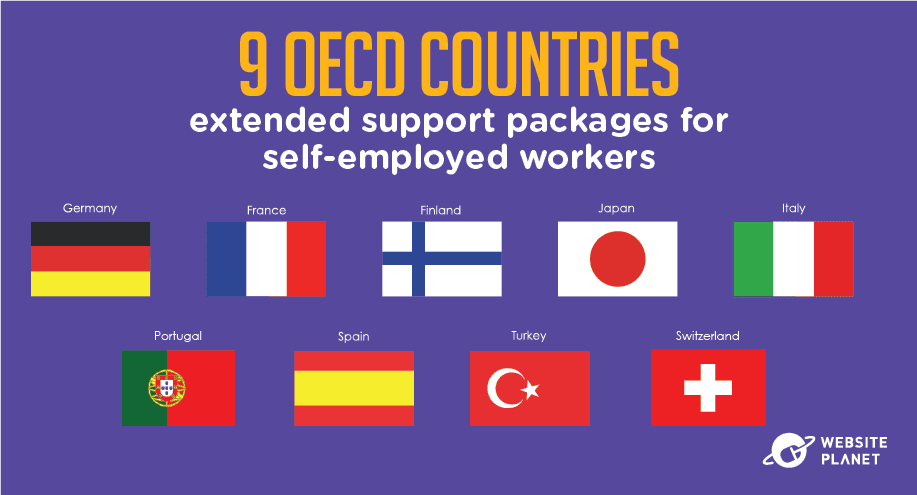 Self-employed and informal workers aren’t typically covered by job retention schemes, but COVID-19 forced many governments to think differently.
In Germany, France, Finland, and 6 other OECD countries, governments extended eligibility of job retention schemes to include temporary, agency, and self-employed workers — protecting them from the drastic impact of lost income and employment.
Self-employed and informal workers aren’t typically covered by job retention schemes, but COVID-19 forced many governments to think differently.
In Germany, France, Finland, and 6 other OECD countries, governments extended eligibility of job retention schemes to include temporary, agency, and self-employed workers — protecting them from the drastic impact of lost income and employment.
55. Take-Up of Job Retention Schemes Varied
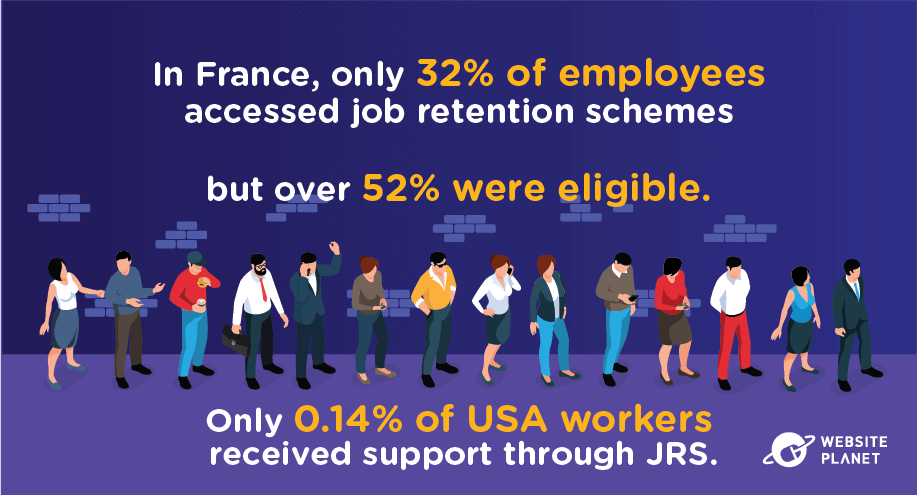 Although many workers qualified for job retention schemes, not everyone felt the benefits. In France, only 32% of employees submitted applications for subsidiary schemes despite over 52% being eligible.
New Zealand held the highest approval rate of any OECD country, giving over 60% of employees access to job retention support. In contrast, only 0.14% of USA workers received the same.
Although many workers qualified for job retention schemes, not everyone felt the benefits. In France, only 32% of employees submitted applications for subsidiary schemes despite over 52% being eligible.
New Zealand held the highest approval rate of any OECD country, giving over 60% of employees access to job retention support. In contrast, only 0.14% of USA workers received the same.
56. Strengthened Protection Against Dismissals
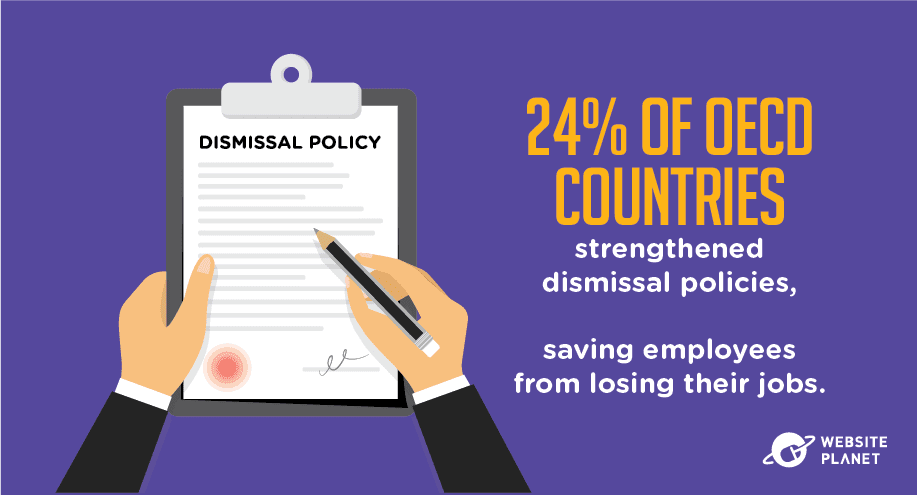 As part of employment subsidiary schemes, governments around the world also strengthened their policies against dismissals. And these are set to stay for the future.
In response to Covid, 24% of OECD countries strengthened dismissal policies to protect employees from being forced out of work.
The OECD has since introduced new regulations around unfair dismissal, including dismissal based on economic and personal reasons. This prevents employers from making significant shifts to their workforce in short periods, usually in response to economic difficulty such as a pandemic.
As part of employment subsidiary schemes, governments around the world also strengthened their policies against dismissals. And these are set to stay for the future.
In response to Covid, 24% of OECD countries strengthened dismissal policies to protect employees from being forced out of work.
The OECD has since introduced new regulations around unfair dismissal, including dismissal based on economic and personal reasons. This prevents employers from making significant shifts to their workforce in short periods, usually in response to economic difficulty such as a pandemic.
57. Growing Support for Labor Unions
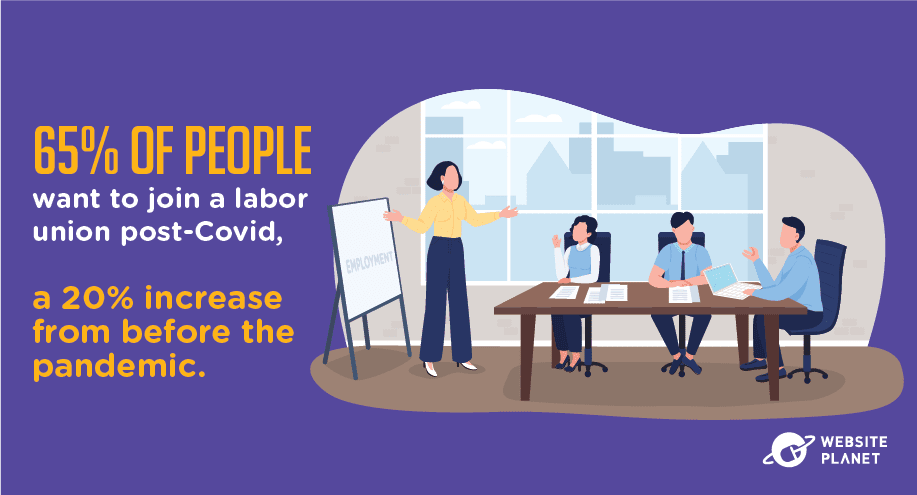 Union membership has steadily declined over recent years, but COVID-19 has encouraged greater public support for unions. In 2018, only 45% of nonunion workers stated they would join a union if they could. Post-pandemic, this percentage now stands at 65%.
With poverty, gender pay gaps, and unemployment rising, the public is looking for ways to get their voices heard and help recover the global workforce from the damage of the pandemic.
Union membership has steadily declined over recent years, but COVID-19 has encouraged greater public support for unions. In 2018, only 45% of nonunion workers stated they would join a union if they could. Post-pandemic, this percentage now stands at 65%.
With poverty, gender pay gaps, and unemployment rising, the public is looking for ways to get their voices heard and help recover the global workforce from the damage of the pandemic.
The Future of Work Is Uncertain, But Comes With Big Changes
One thing is certain. COVID-19 has changed the way we work forever. As employees head back to the office and normal productivity resumes, just what does the future have in store for the global workforce?58. Return to Pre-Pandemic Employment Rates Is Long
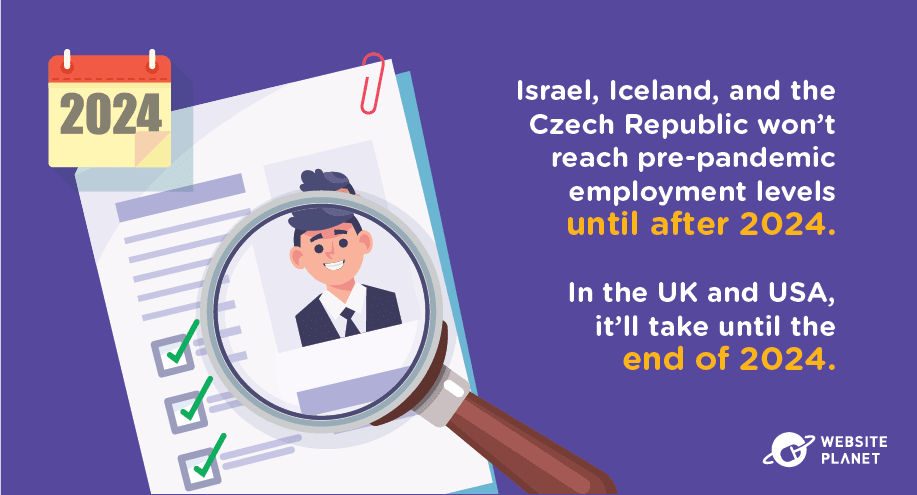 Restrictions have loosened, and many of us are returning to the “new normal.” That also means many changes for the global job market, with workplaces looking to fill new positions.
While we’re seeing a surge in new job vacancies, it’s going to take a long time for countries to recover to pre-pandemic employment levels.
Some countries, including Israel, Iceland, and the Czech Republic, won’t reach pre-pandemic employment levels until after 2024. Even for the UK and USA, it’s estimated that it’ll take until the end of 2024.
Restrictions have loosened, and many of us are returning to the “new normal.” That also means many changes for the global job market, with workplaces looking to fill new positions.
While we’re seeing a surge in new job vacancies, it’s going to take a long time for countries to recover to pre-pandemic employment levels.
Some countries, including Israel, Iceland, and the Czech Republic, won’t reach pre-pandemic employment levels until after 2024. Even for the UK and USA, it’s estimated that it’ll take until the end of 2024.
59. Many Are Out of Work and Not Looking for New Roles
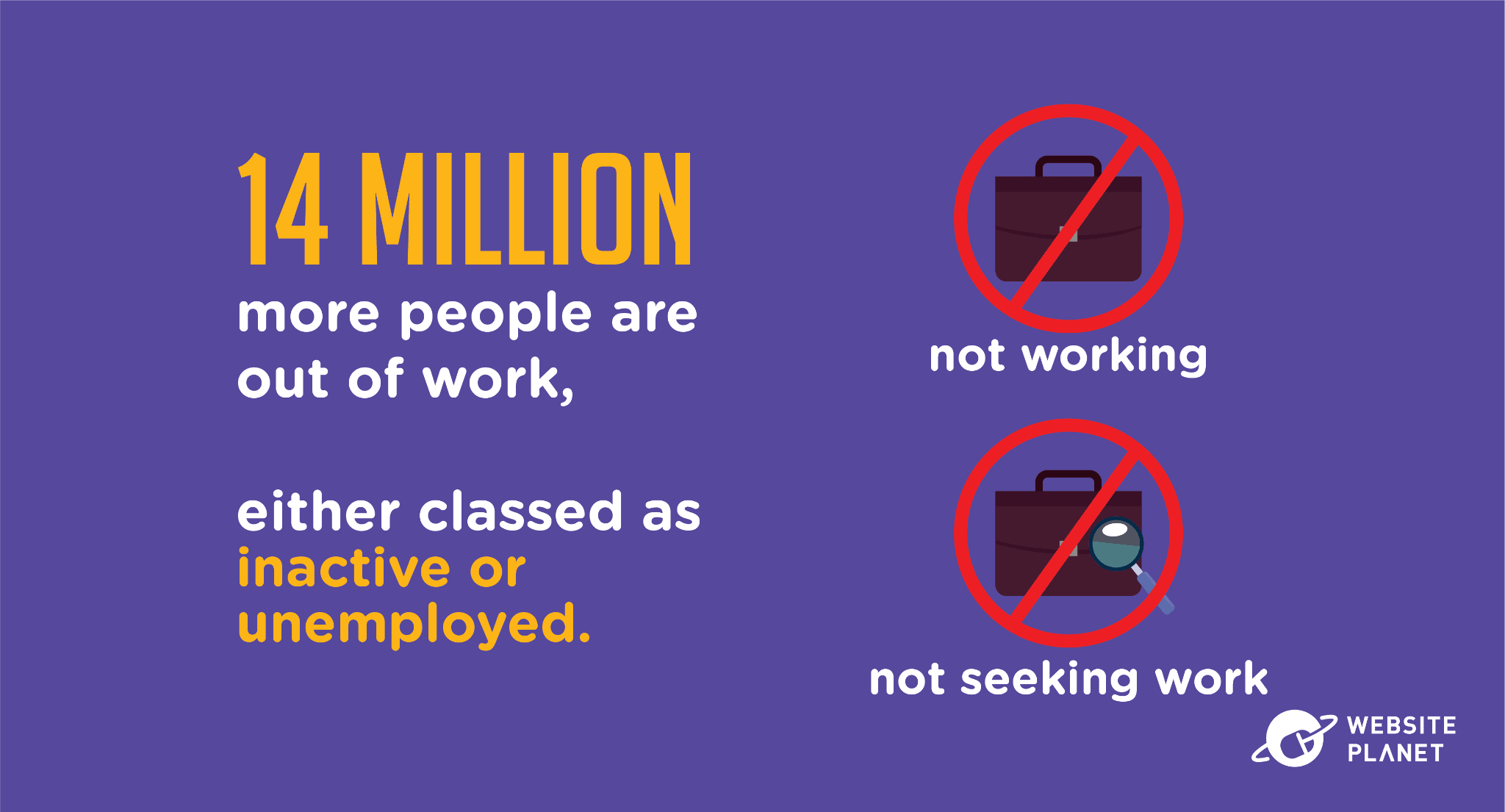 With countries slow to recover, the number of people out of work and suffering from loss of income is rising. However, much of the global workforce is no longer employed, but not looking for new positions.
Across OECD countries, around 14 million more people are currently inactive, meaning they are either out of work or not seeking new employment. For many, this may result from job retention schemes, but others are perhaps waiting to see what else comes along.
With countries slow to recover, the number of people out of work and suffering from loss of income is rising. However, much of the global workforce is no longer employed, but not looking for new positions.
Across OECD countries, around 14 million more people are currently inactive, meaning they are either out of work or not seeking new employment. For many, this may result from job retention schemes, but others are perhaps waiting to see what else comes along.
60. Many Want to Quit Their Jobs
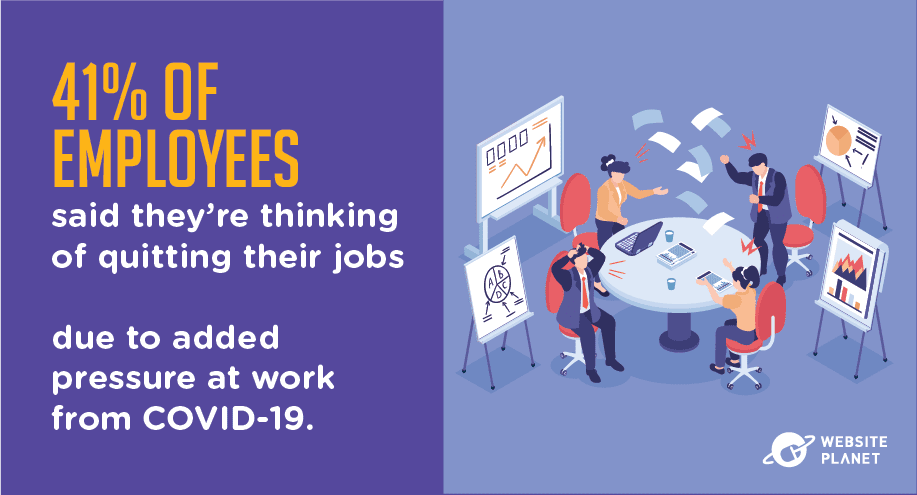 The world of work has been severely disrupted by the pandemic, but it’s also brought in new ways of working. People were forced to work at home in siloed conditions and, as a result, most worked much longer days.
Around 41% of employees said they’re currently looking to quit their jobs, particularly because of burnout. During Covid, the average working day increased by over 48 minutes with 13% more meetings each day — leaving much of the global workforce tired and overworked.
The world of work has been severely disrupted by the pandemic, but it’s also brought in new ways of working. People were forced to work at home in siloed conditions and, as a result, most worked much longer days.
Around 41% of employees said they’re currently looking to quit their jobs, particularly because of burnout. During Covid, the average working day increased by over 48 minutes with 13% more meetings each day — leaving much of the global workforce tired and overworked.
61. Remote Working Is Here to Stay
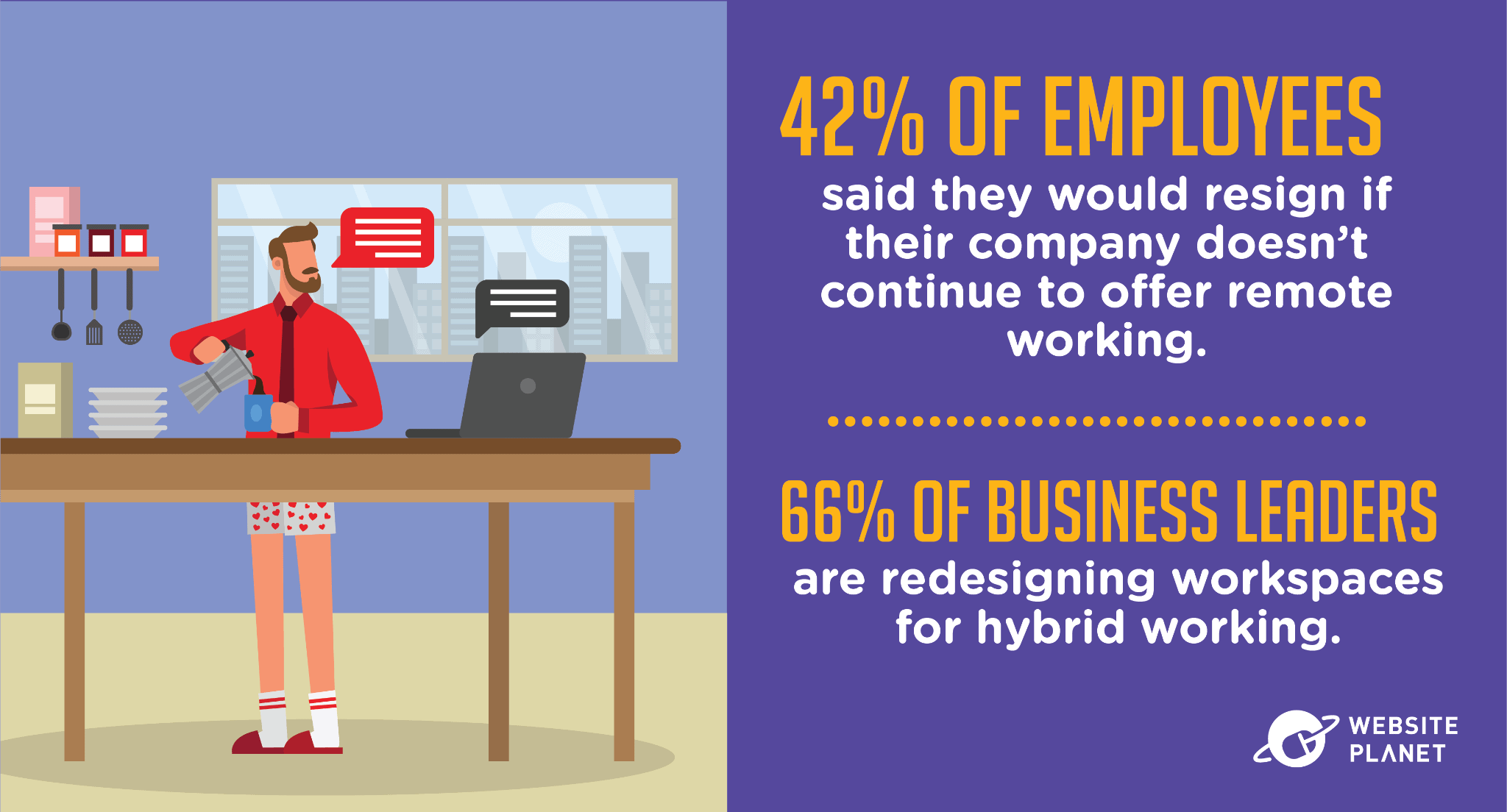 It seems that the pandemic has caused an enormous shift not only in the way we work, but where.
In a US survey, 42% of employees said they would consider handing in their resignation if their company did not offer remote working options long-term. Yet 67% of employees also want more in-person work and collaboration post-pandemic.
Employees want the best of both worlds, and companies are listening. 66% of business leaders said their company is redesigning their office space to encourage hybrid working, allowing employees to do a mixture of remote and office work.
It seems that the pandemic has caused an enormous shift not only in the way we work, but where.
In a US survey, 42% of employees said they would consider handing in their resignation if their company did not offer remote working options long-term. Yet 67% of employees also want more in-person work and collaboration post-pandemic.
Employees want the best of both worlds, and companies are listening. 66% of business leaders said their company is redesigning their office space to encourage hybrid working, allowing employees to do a mixture of remote and office work.
62. People Are Cautious of Returns to the Office
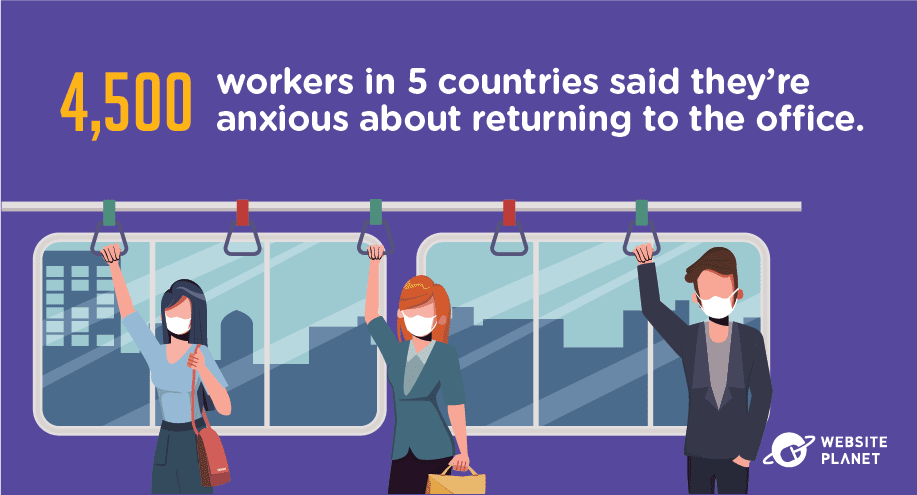 Although some employees want to return to the office, even on a part-time basis, the thought of doing so is raising levels of anxiety.
A new study found that out of over 4,500 workers in 5 countries, all reported feeling anxious about returning to the office. The top reasons for this increased anxiety were being exposed to COVID-19, losing work flexibility, and financial burdens such as fuel and childcare. The response shows just how crucial flexible working is.
Although some employees want to return to the office, even on a part-time basis, the thought of doing so is raising levels of anxiety.
A new study found that out of over 4,500 workers in 5 countries, all reported feeling anxious about returning to the office. The top reasons for this increased anxiety were being exposed to COVID-19, losing work flexibility, and financial burdens such as fuel and childcare. The response shows just how crucial flexible working is.
63. Third Space Venues Are the New Office
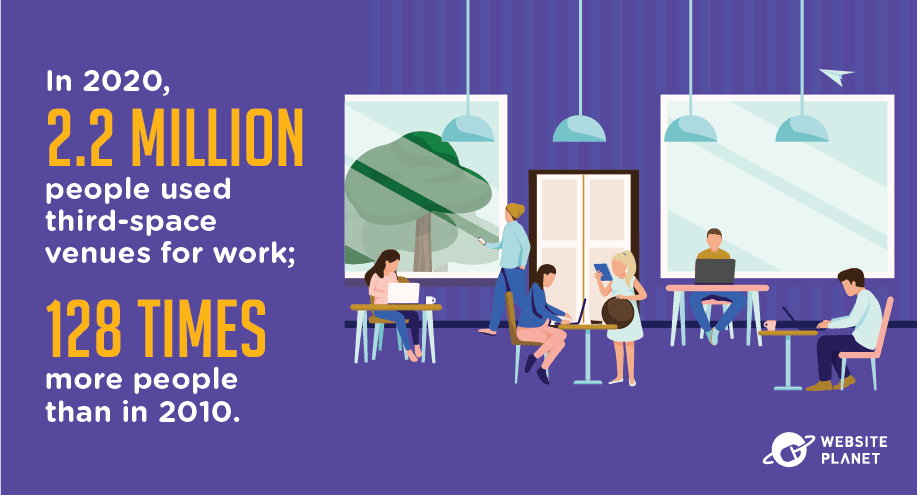 The workplace office and the kitchen dining table aren’t the only options for remote working. Third-space venues such as restaurants, hotels, and cafés have offered up their premises for workers around the globe.
In 2020, 2.2 million people worldwide used a third space venue as a working location — almost 128 times more people than in 2010. And, as many companies move towards a hybrid working model, it looks like laptops in restaurants are here to stay.
The workplace office and the kitchen dining table aren’t the only options for remote working. Third-space venues such as restaurants, hotels, and cafés have offered up their premises for workers around the globe.
In 2020, 2.2 million people worldwide used a third space venue as a working location — almost 128 times more people than in 2010. And, as many companies move towards a hybrid working model, it looks like laptops in restaurants are here to stay.
64. Upskilling and Reskilling Employees Are Key
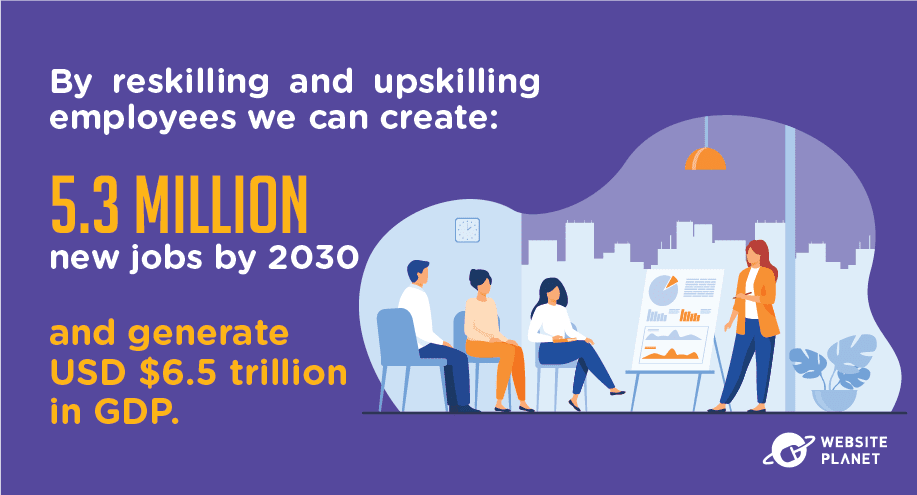 COVID-19 has created a surge in unemployment levels and widened inequalities in the global job market, including those relating to gender and skills. And it’s also caused global GDP to plummet fast.
But reskilling and upskilling employees is one way many governments believe we can effectively recover from the effects of the pandemic. Investing in training and development to help employees succeed in the future workplace is thought to boost global GDP by US$6.5 trillion and create 5.3 million new jobs by 2030.
COVID-19 has created a surge in unemployment levels and widened inequalities in the global job market, including those relating to gender and skills. And it’s also caused global GDP to plummet fast.
But reskilling and upskilling employees is one way many governments believe we can effectively recover from the effects of the pandemic. Investing in training and development to help employees succeed in the future workplace is thought to boost global GDP by US$6.5 trillion and create 5.3 million new jobs by 2030.
65. But We Also Need New Skills…
 The future workplace looks very different. And with these changes comes a demand for new skills.
In 2015, the top 3 skills included complex problem solving, coordinating with others, and people management. But for 2021 and beyond, there’s a greater focus on analytical thinking and innovation, creativity, and active learning, alongside complex problem-solving.
If we’re to equip our workforce for the future (and help the currently unemployed find work), an investment in training is a sure way to go.
The future workplace looks very different. And with these changes comes a demand for new skills.
In 2015, the top 3 skills included complex problem solving, coordinating with others, and people management. But for 2021 and beyond, there’s a greater focus on analytical thinking and innovation, creativity, and active learning, alongside complex problem-solving.
If we’re to equip our workforce for the future (and help the currently unemployed find work), an investment in training is a sure way to go.
66. Gen Z are Driving Learning
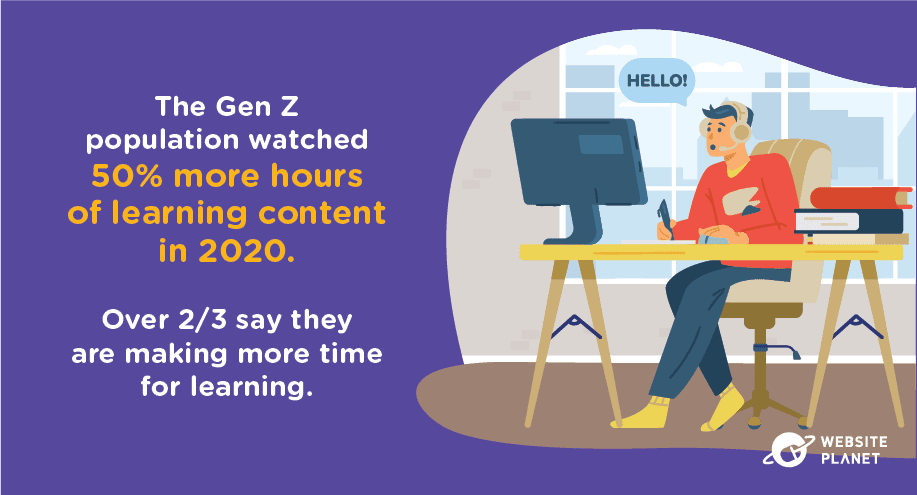 Businesses that want to attract and retain employees need to invest in learning programs. The Gen Z population (aged 18-24) is passionate about learning, and the pandemic has only driven this forward.
During COVID-19, the Gen Z population watched 50% more hours of learning content on LinkedIn than in 2019. And over two-thirds of respondents reported making more time available to learn new skills or deepen their knowledge.
Businesses that want to attract and retain employees need to invest in learning programs. The Gen Z population (aged 18-24) is passionate about learning, and the pandemic has only driven this forward.
During COVID-19, the Gen Z population watched 50% more hours of learning content on LinkedIn than in 2019. And over two-thirds of respondents reported making more time available to learn new skills or deepen their knowledge.
67. Data and AI Jobs on the Rise
 Many businesses were forced to digitize their processes due to the pandemic, whether to support employees working remotely, or to cope with growing production demand due to a rise in e-commerce.
Artificial intelligence (AI) and data jobs were already growing pre-pandemic as our world becomes ever digital. But now, things are accelerating quickly. By 2022, around 100 out of every 100,000 job opportunities globally will be related to data and AI.
Many businesses were forced to digitize their processes due to the pandemic, whether to support employees working remotely, or to cope with growing production demand due to a rise in e-commerce.
Artificial intelligence (AI) and data jobs were already growing pre-pandemic as our world becomes ever digital. But now, things are accelerating quickly. By 2022, around 100 out of every 100,000 job opportunities globally will be related to data and AI.
68. AI Poses a Risk to Our Current Labor Market
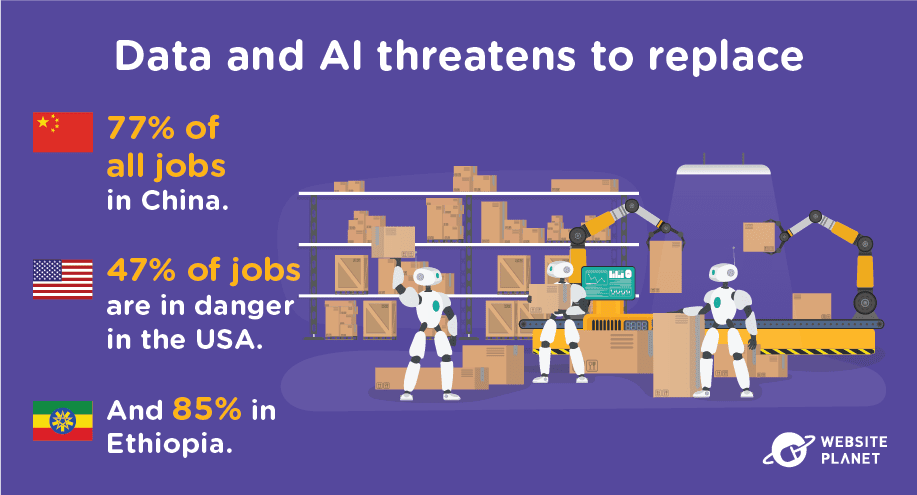 Data and AI will drive a change in the types of jobs available in the future, but it also poses a risk to the number of jobs available.
The number of jobs at risk of being replaced by automation is growing around the world. In China, AI threatens to replace 77% of jobs by 2035. In Ethiopia, this percentage increases to 85%. In the USA, risk remains high at 45%.
Reskilling employees in data management and AI is essential for the future global job market, but our innovation in this sector may leave many unemployed too.
Data and AI will drive a change in the types of jobs available in the future, but it also poses a risk to the number of jobs available.
The number of jobs at risk of being replaced by automation is growing around the world. In China, AI threatens to replace 77% of jobs by 2035. In Ethiopia, this percentage increases to 85%. In the USA, risk remains high at 45%.
Reskilling employees in data management and AI is essential for the future global job market, but our innovation in this sector may leave many unemployed too.
69. New Professions Emerging From the Pandemic
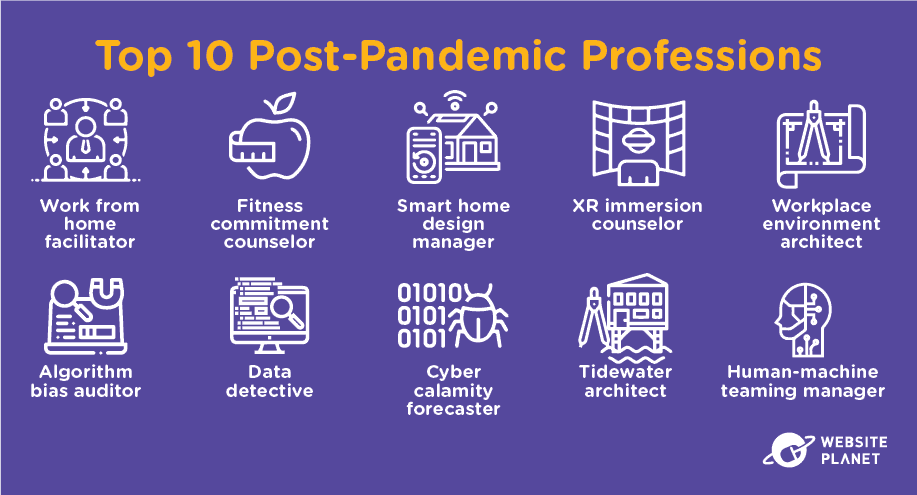 We anticipate a significant transformation in the global job market. The pandemic has brought about substantial changes in our work methods, work locations, consumption patterns, and the importance we assign to various skills or lack thereof. Consequently, new employment opportunities are surfacing.
Some of the new professions emerging from the pandemic include home facilitators, fitness commitment counselors, smart home design managers, data detectives, and workplace environment architects.
We anticipate a significant transformation in the global job market. The pandemic has brought about substantial changes in our work methods, work locations, consumption patterns, and the importance we assign to various skills or lack thereof. Consequently, new employment opportunities are surfacing.
Some of the new professions emerging from the pandemic include home facilitators, fitness commitment counselors, smart home design managers, data detectives, and workplace environment architects.


